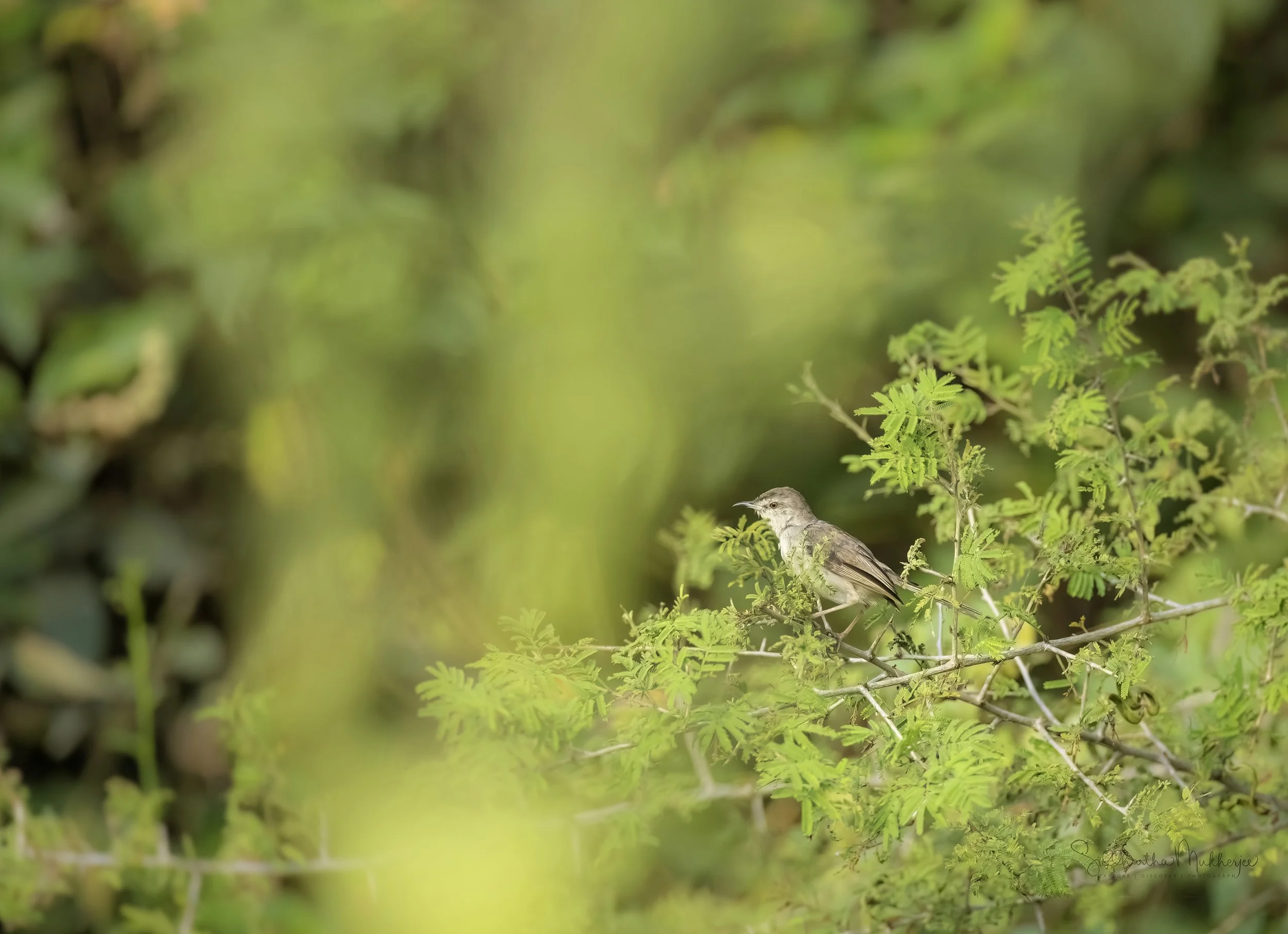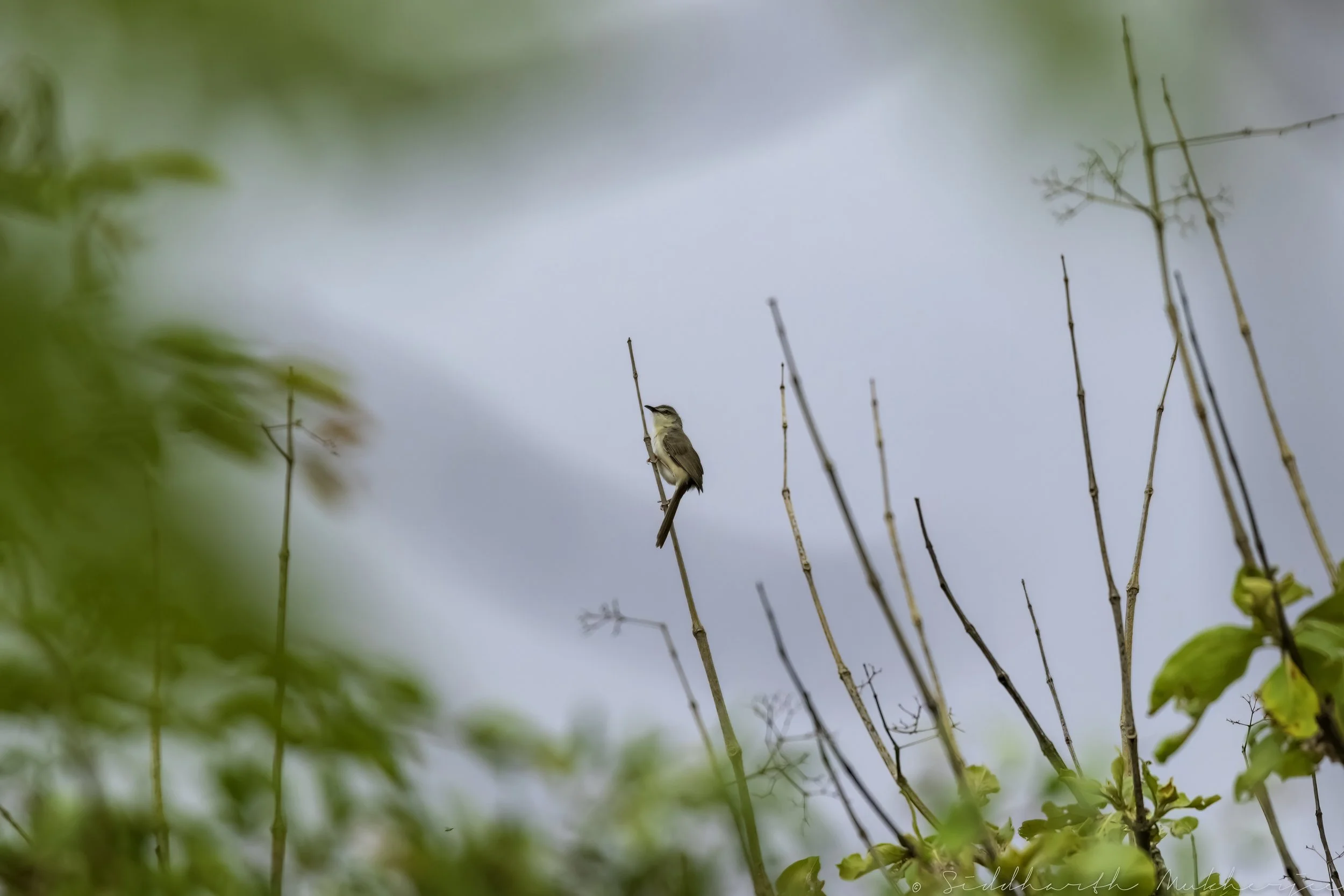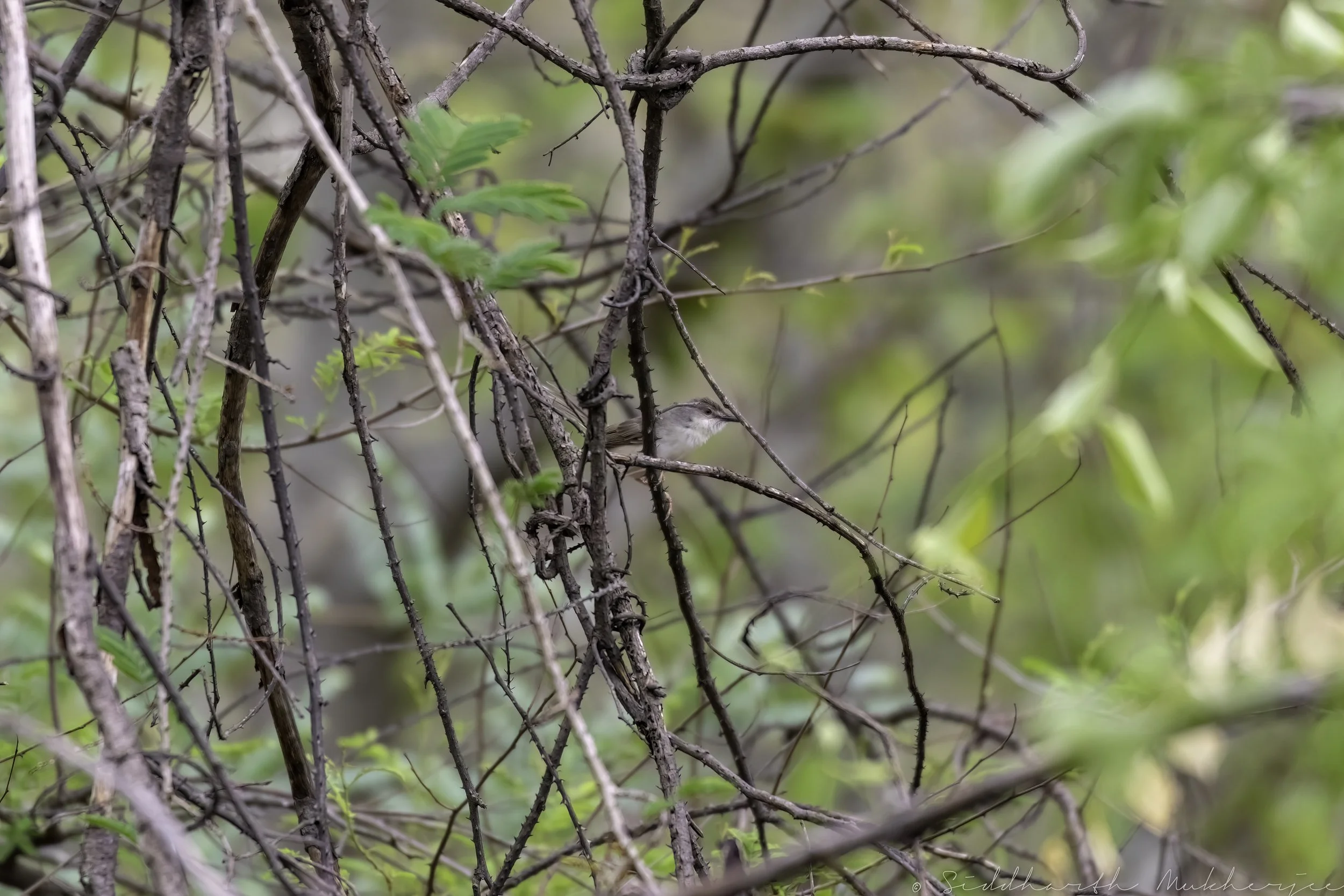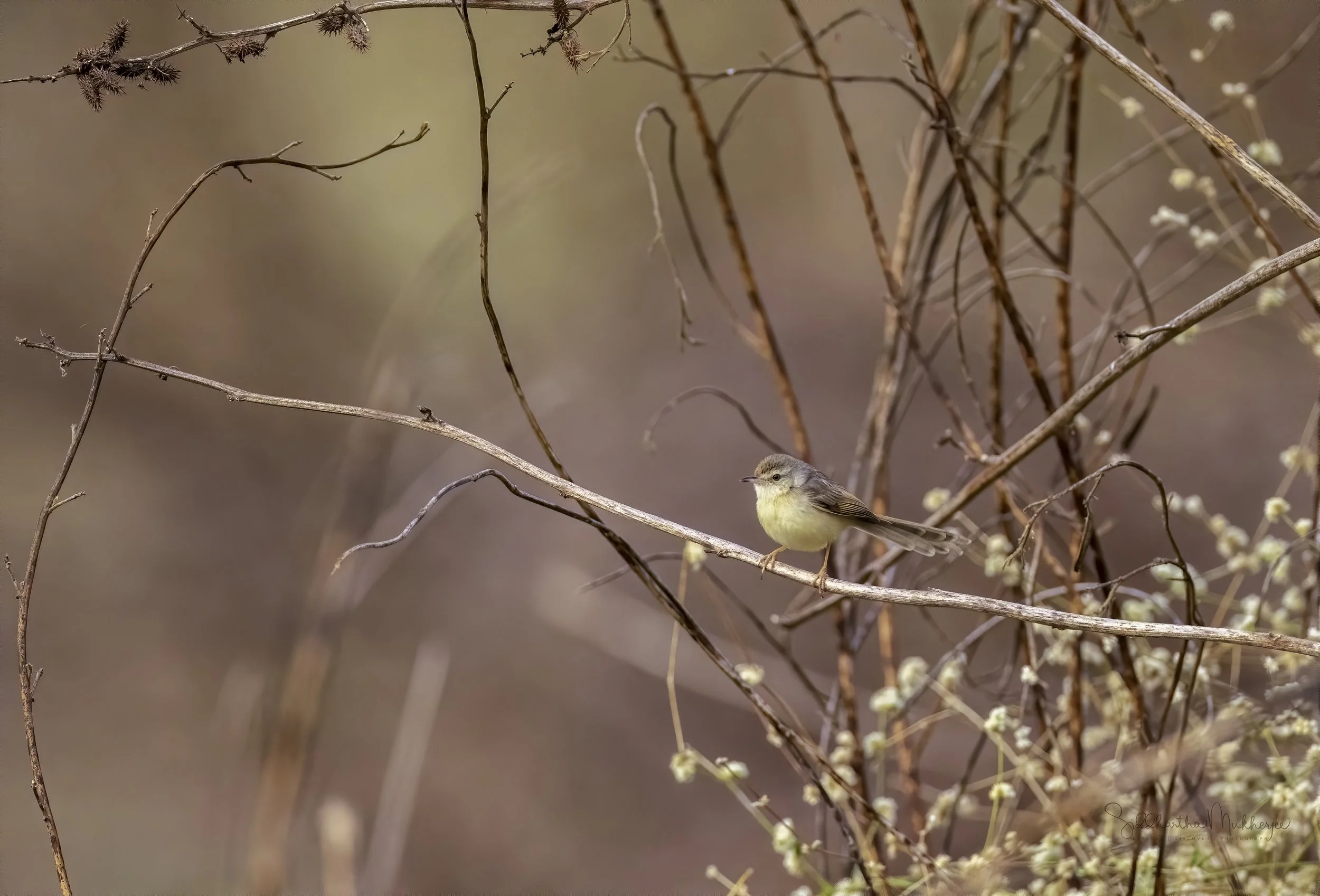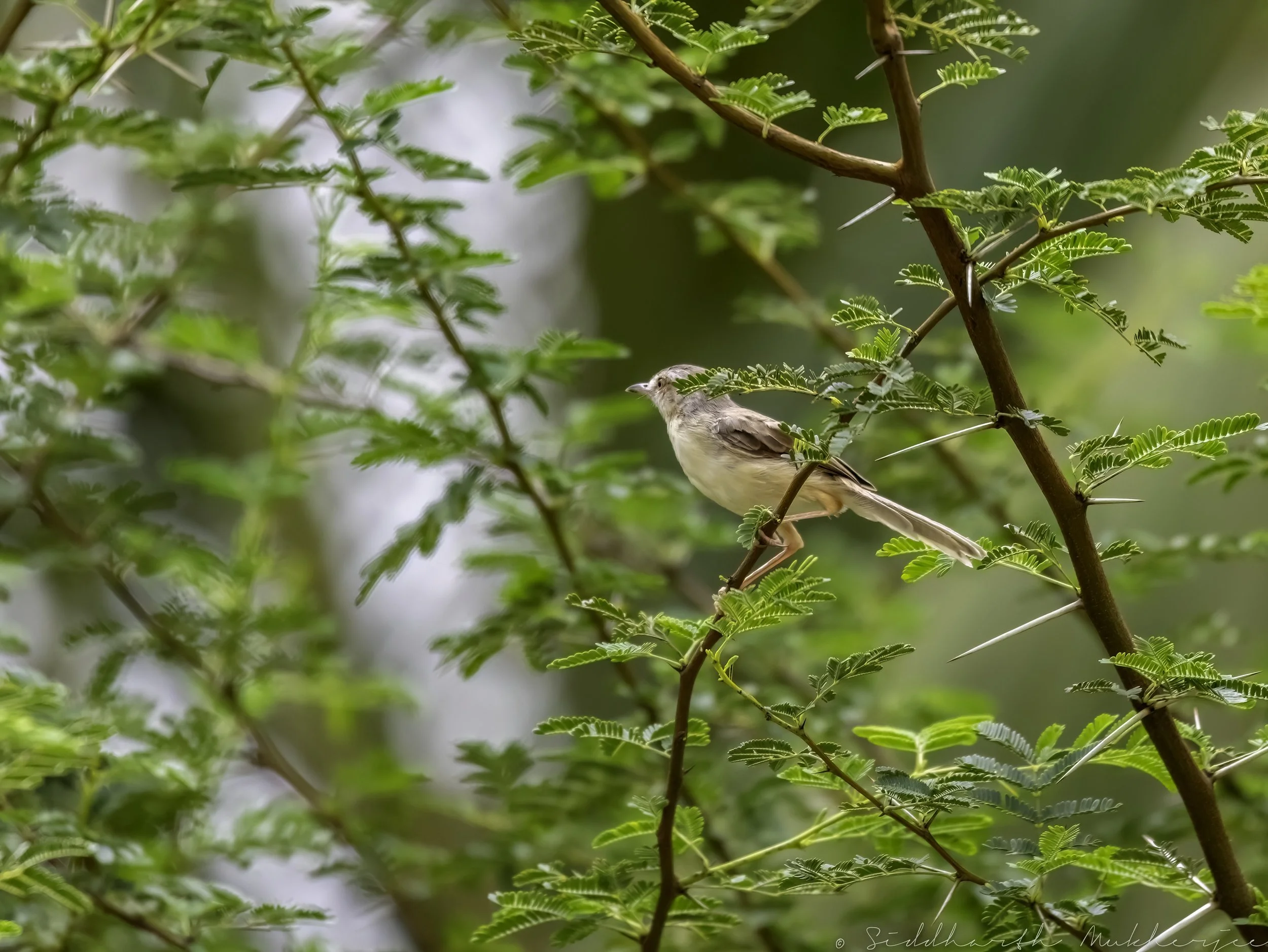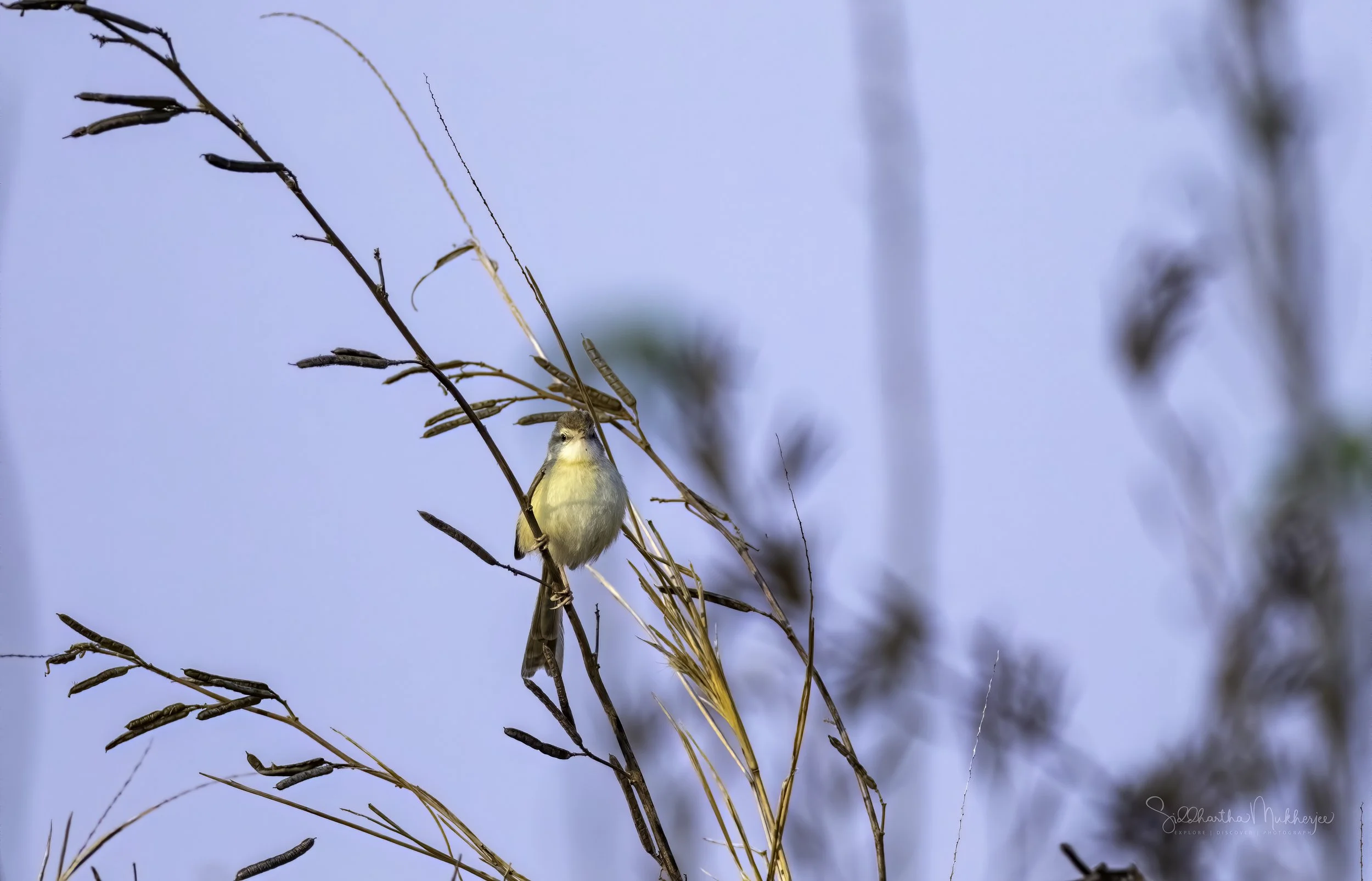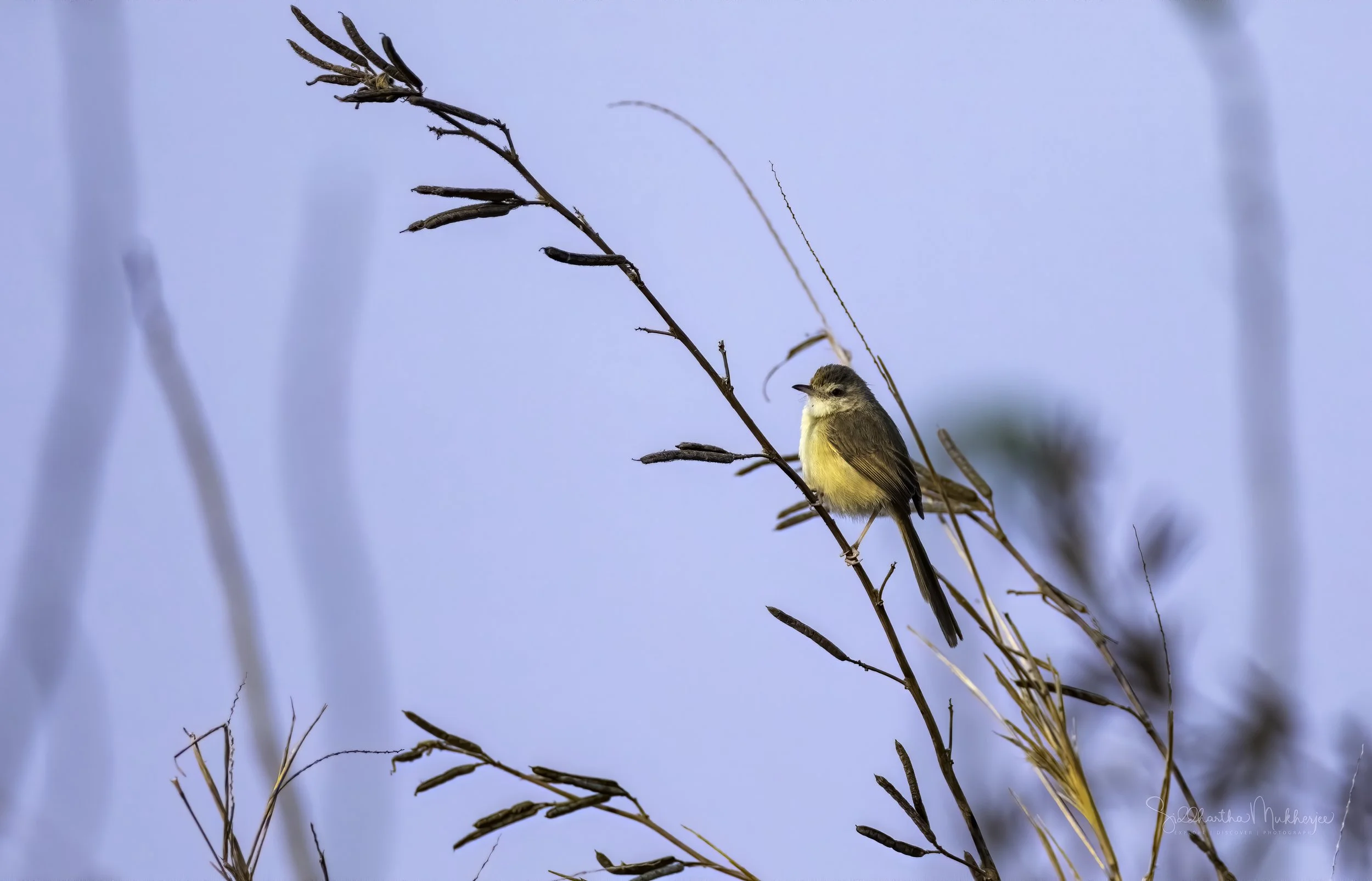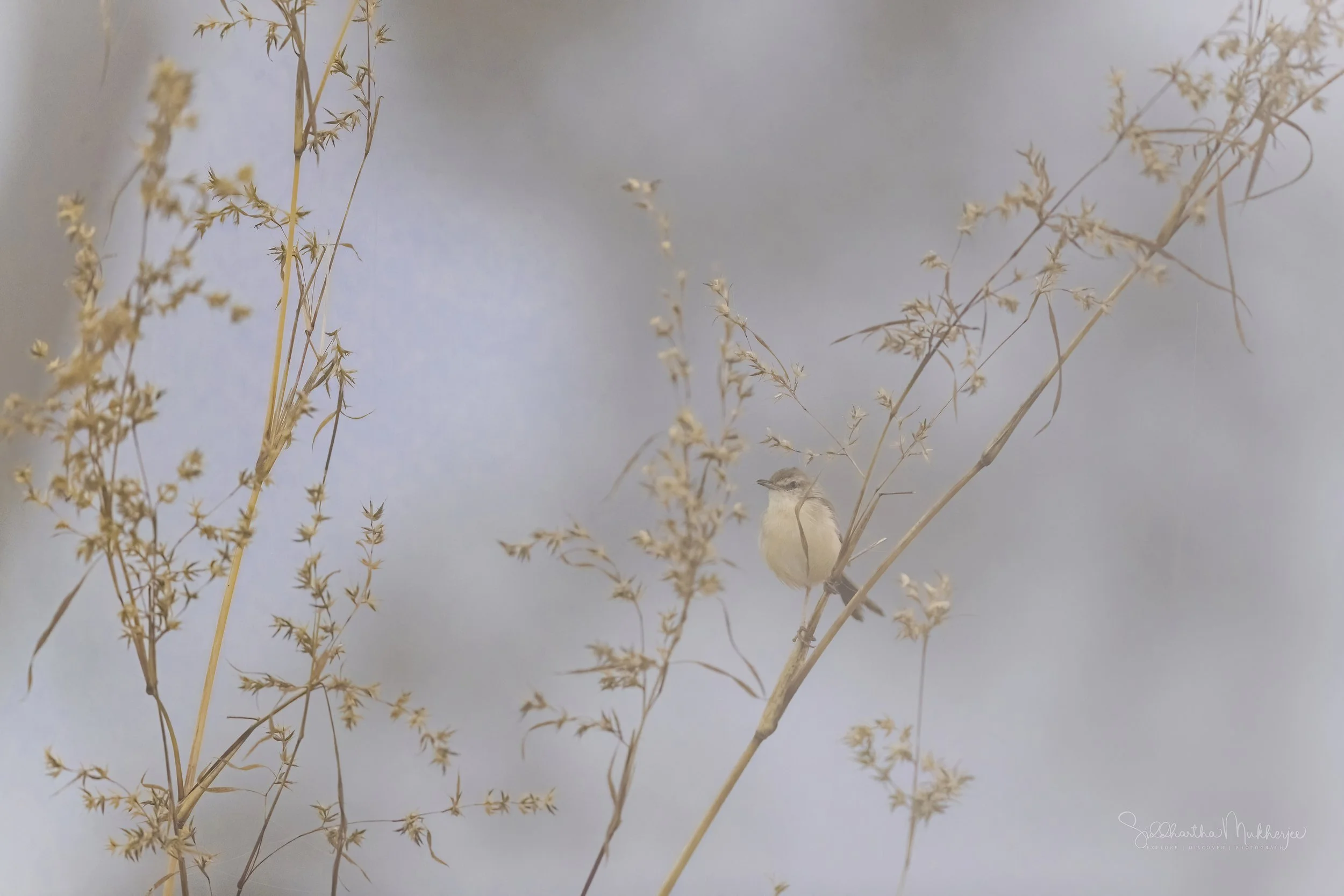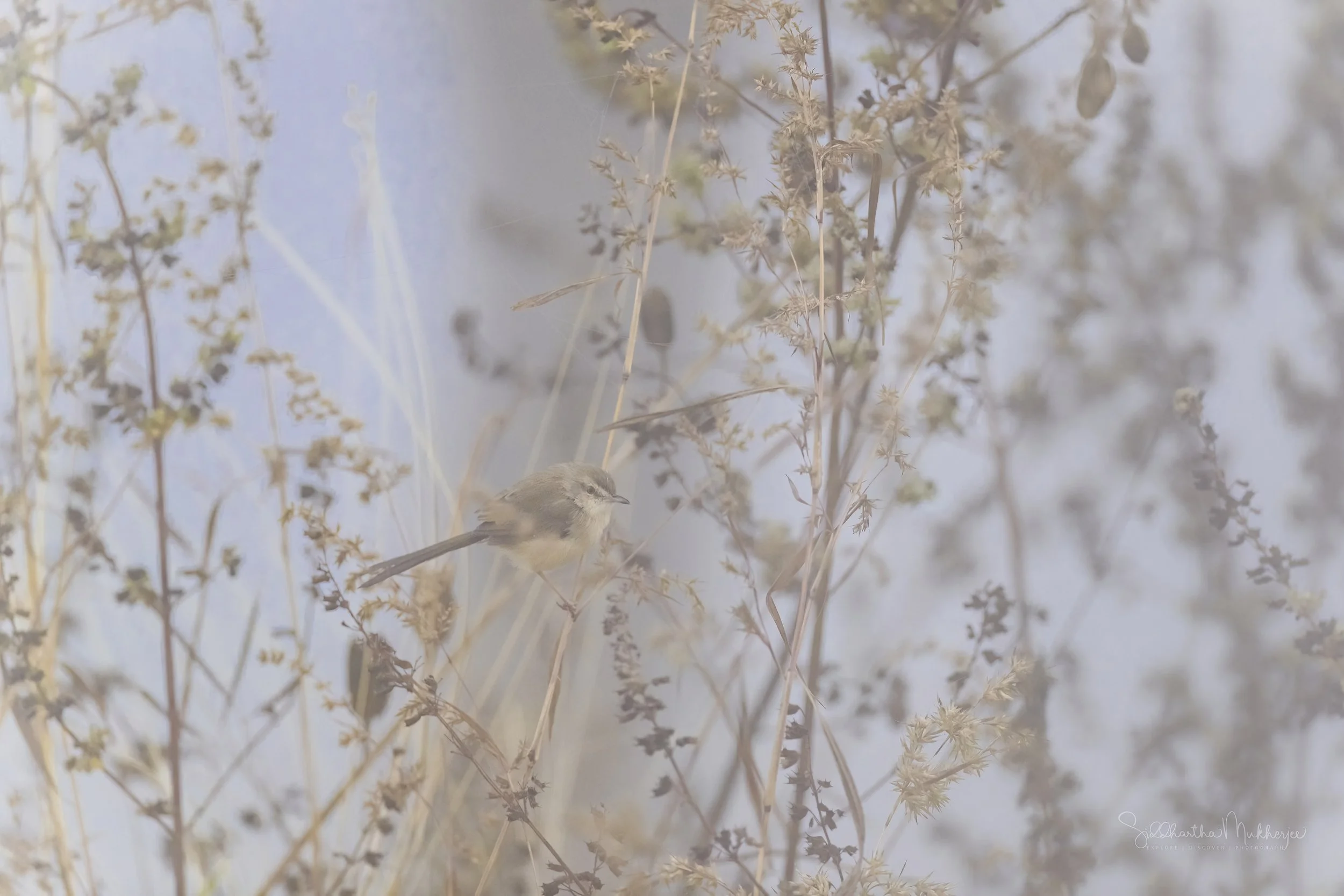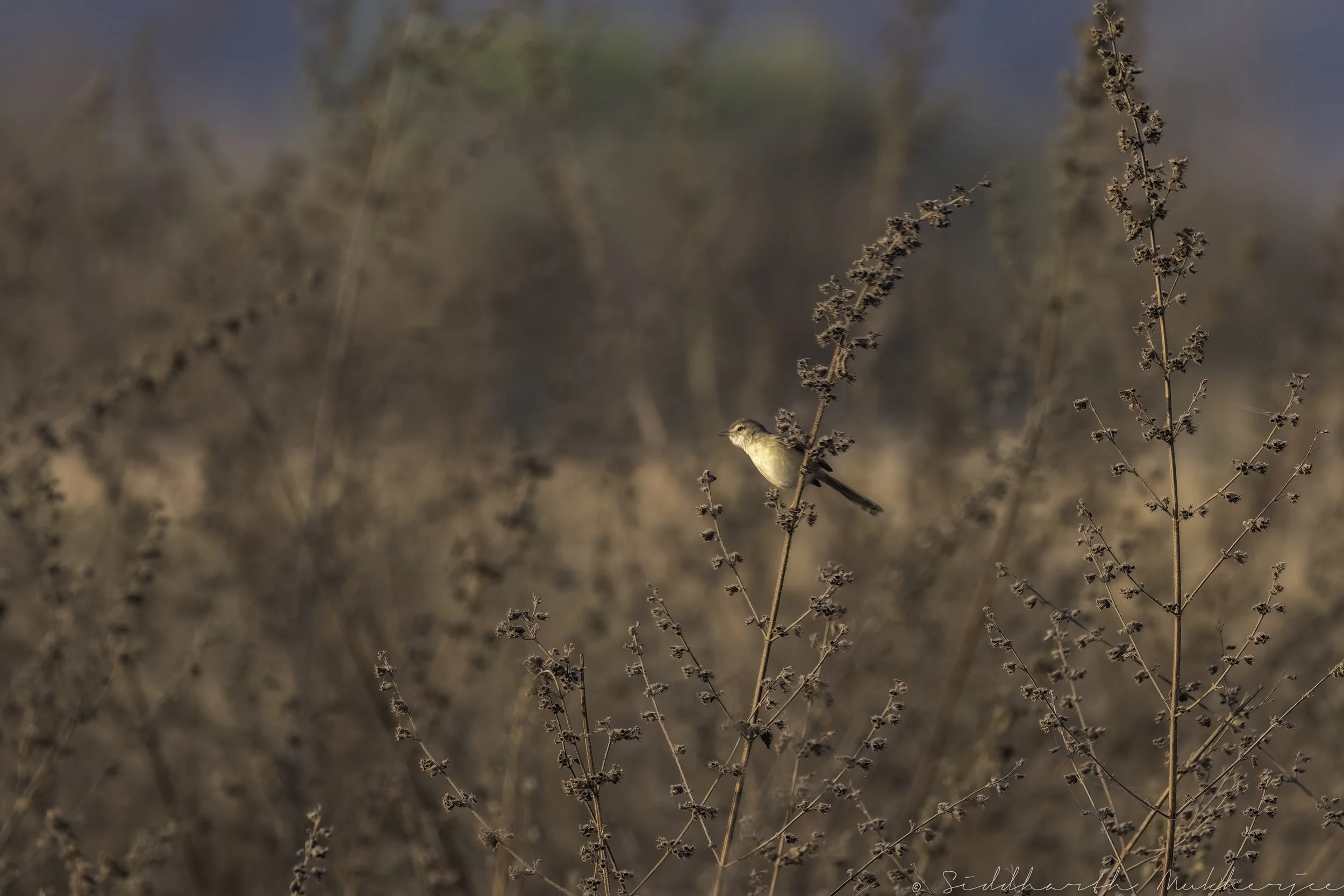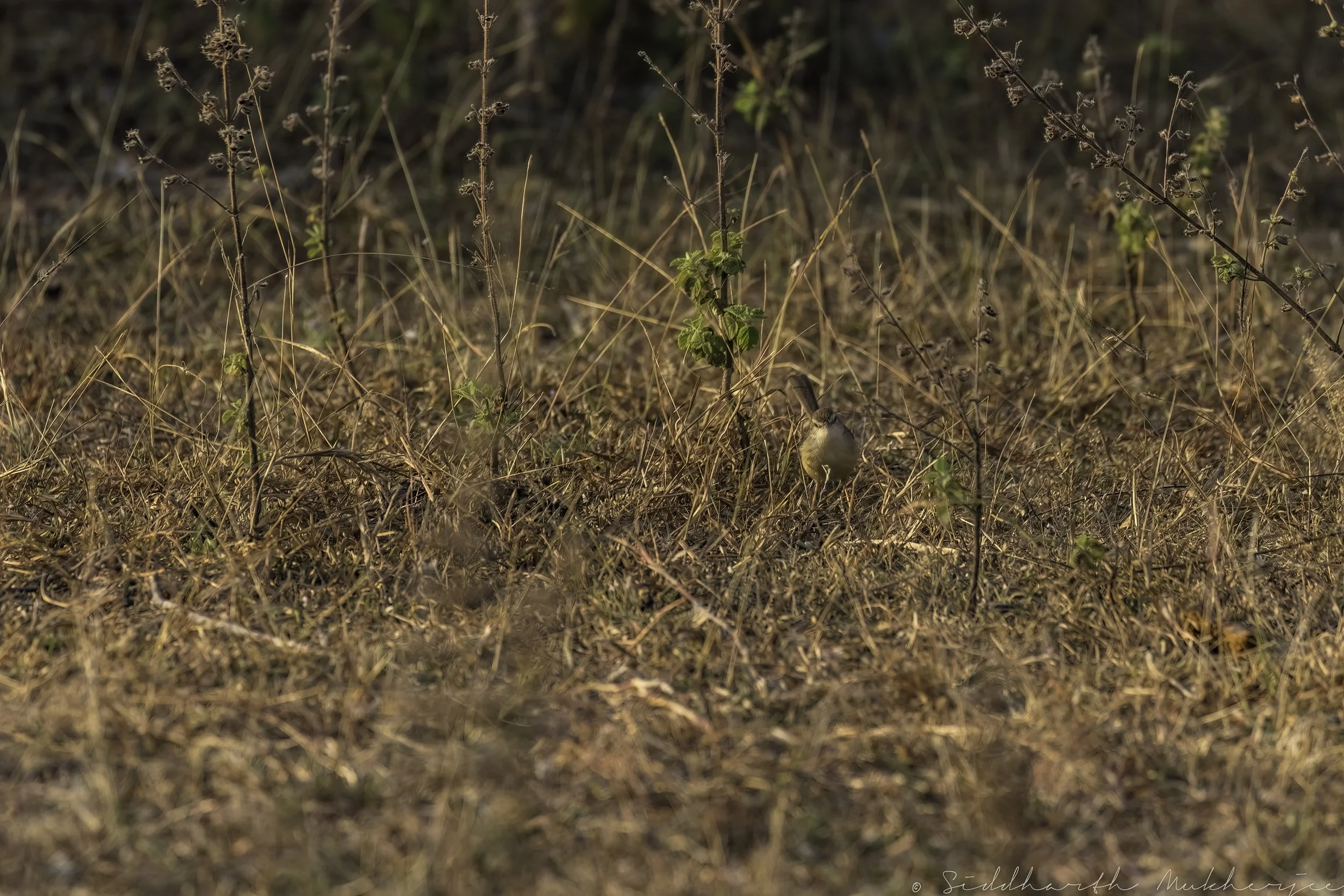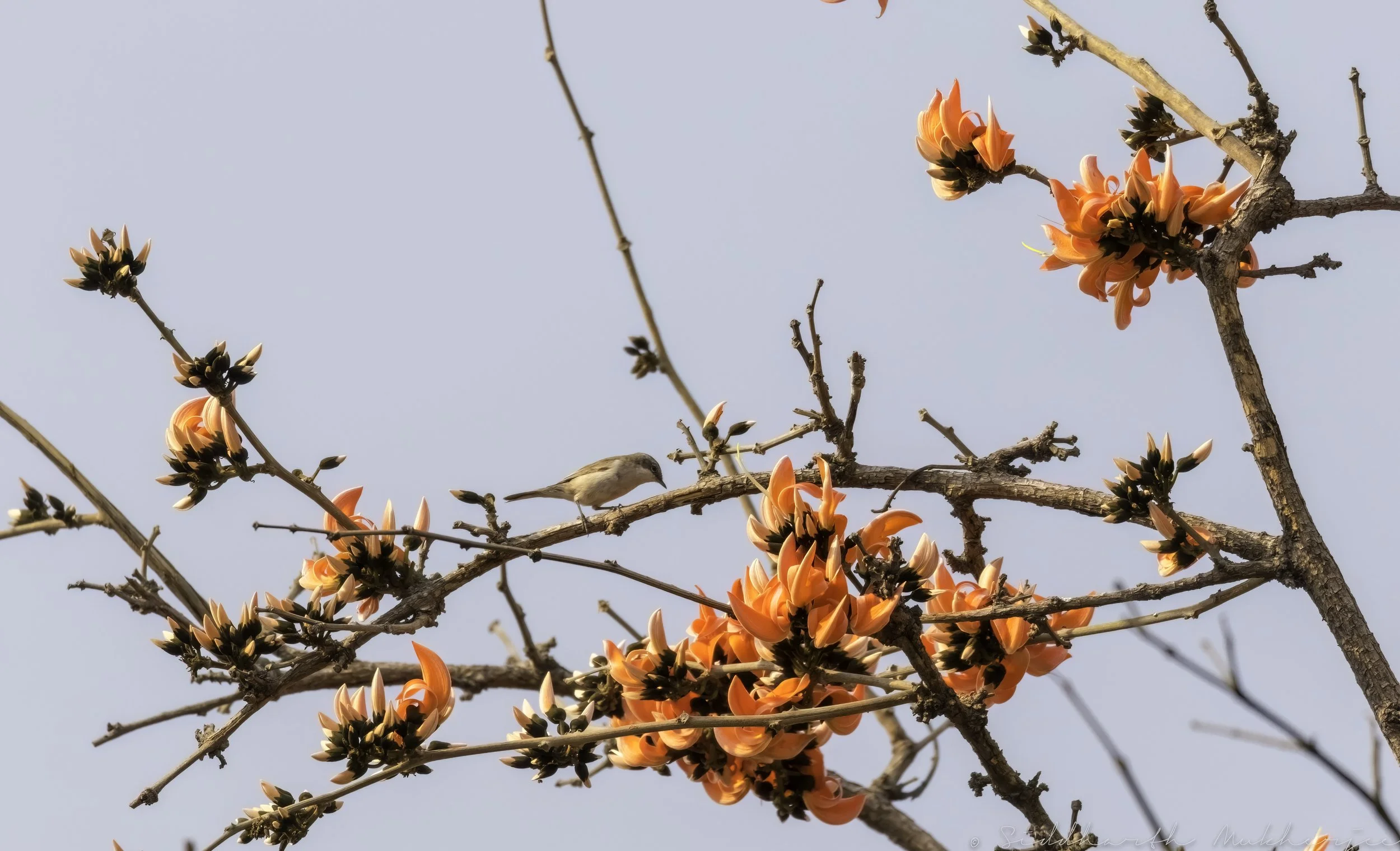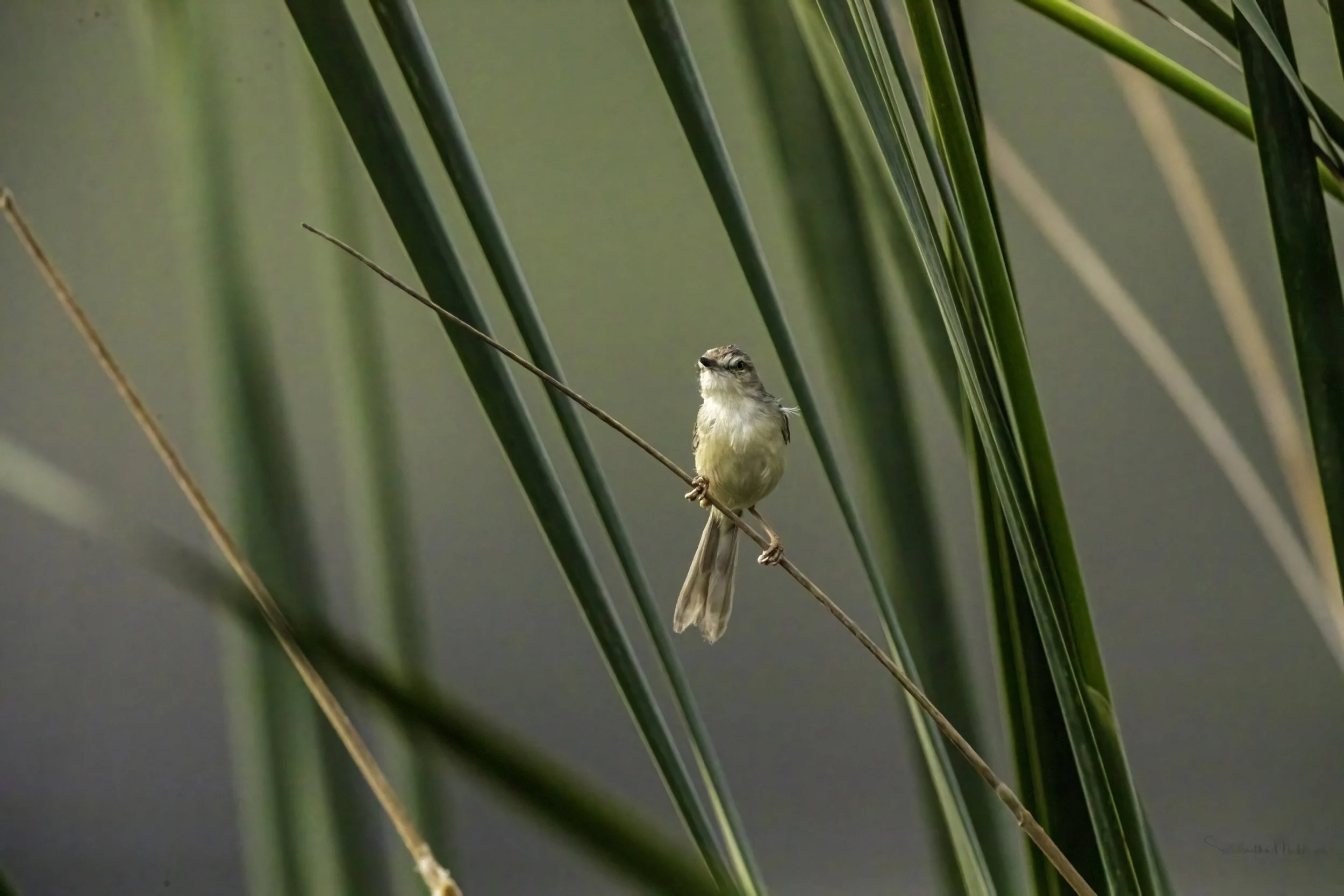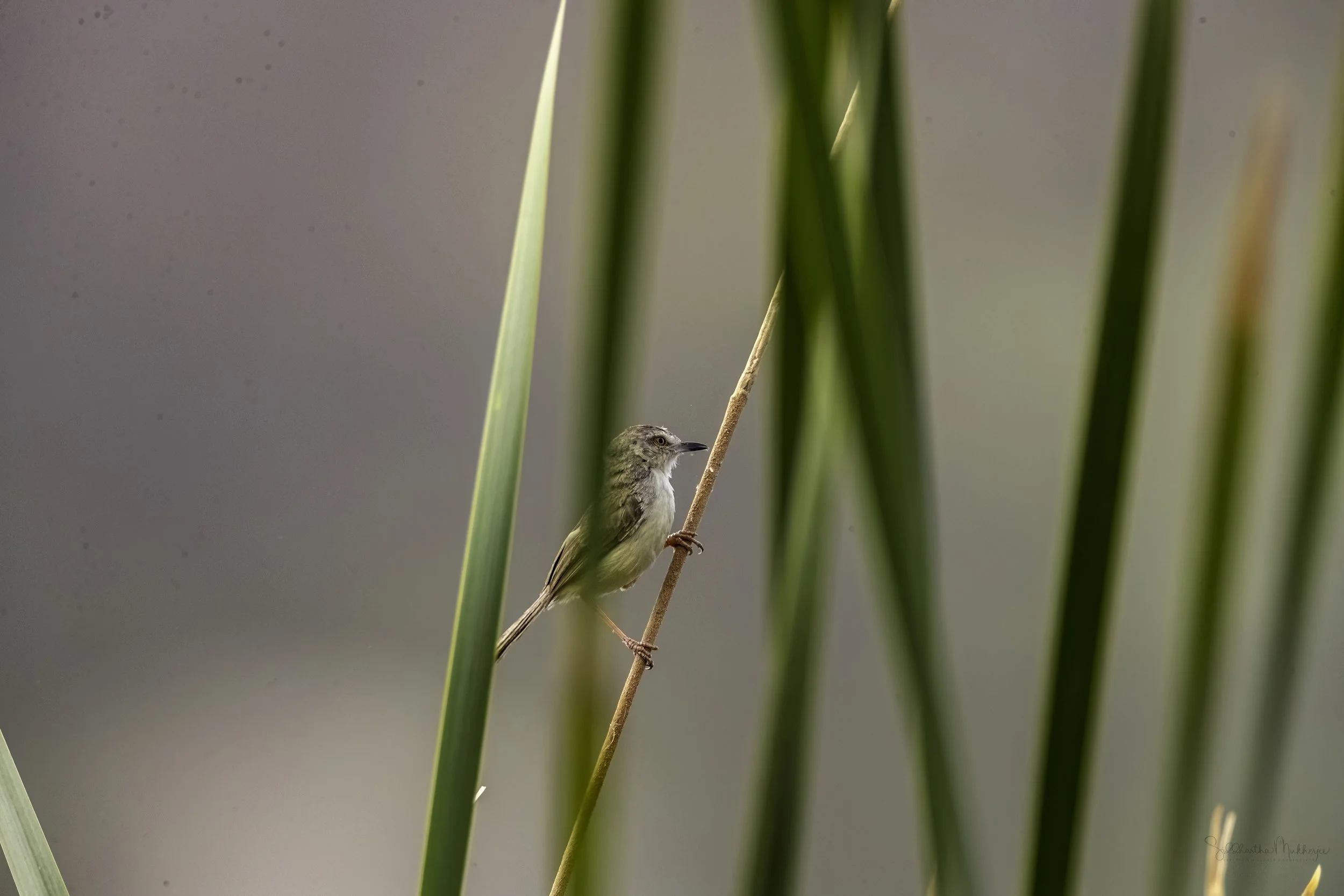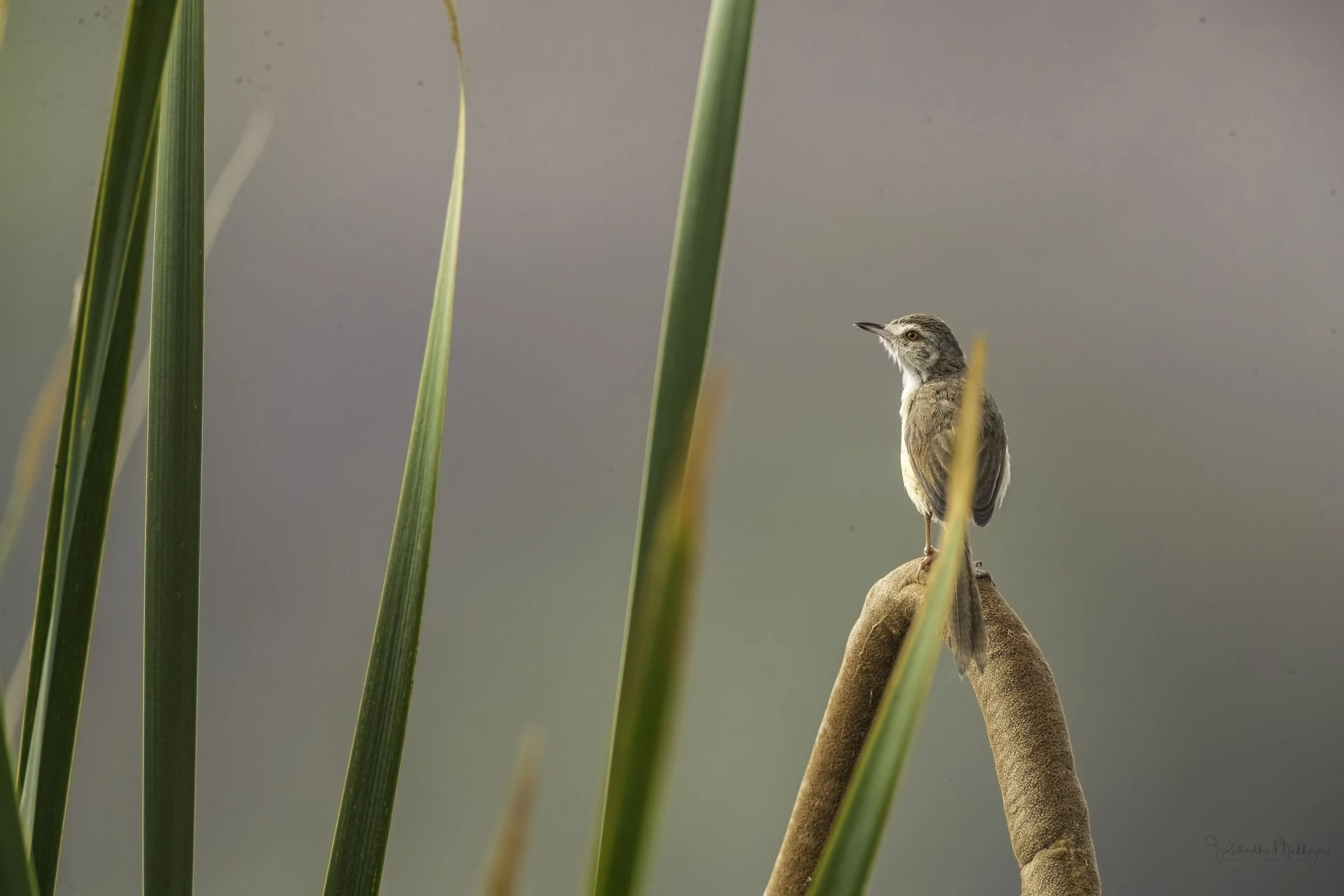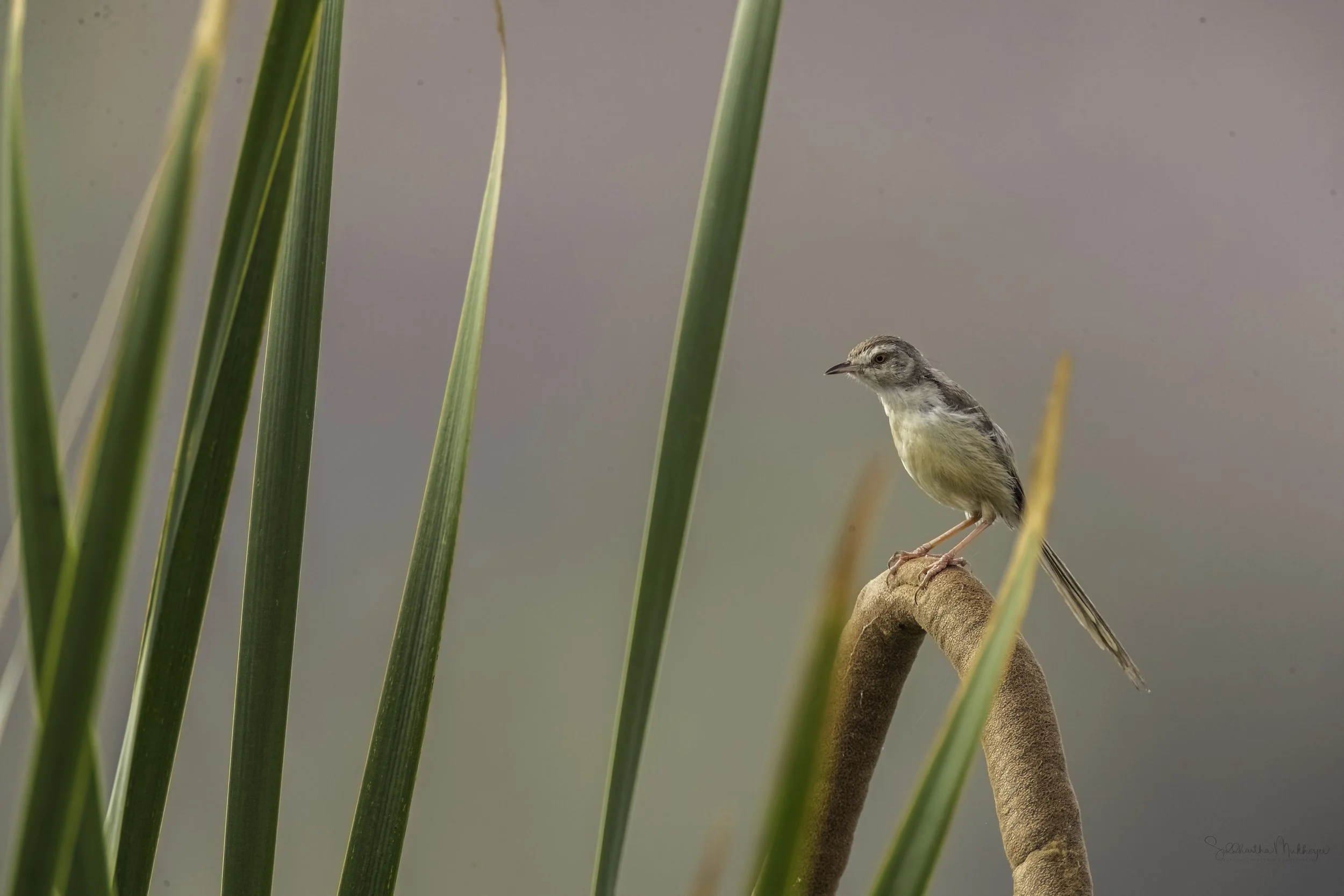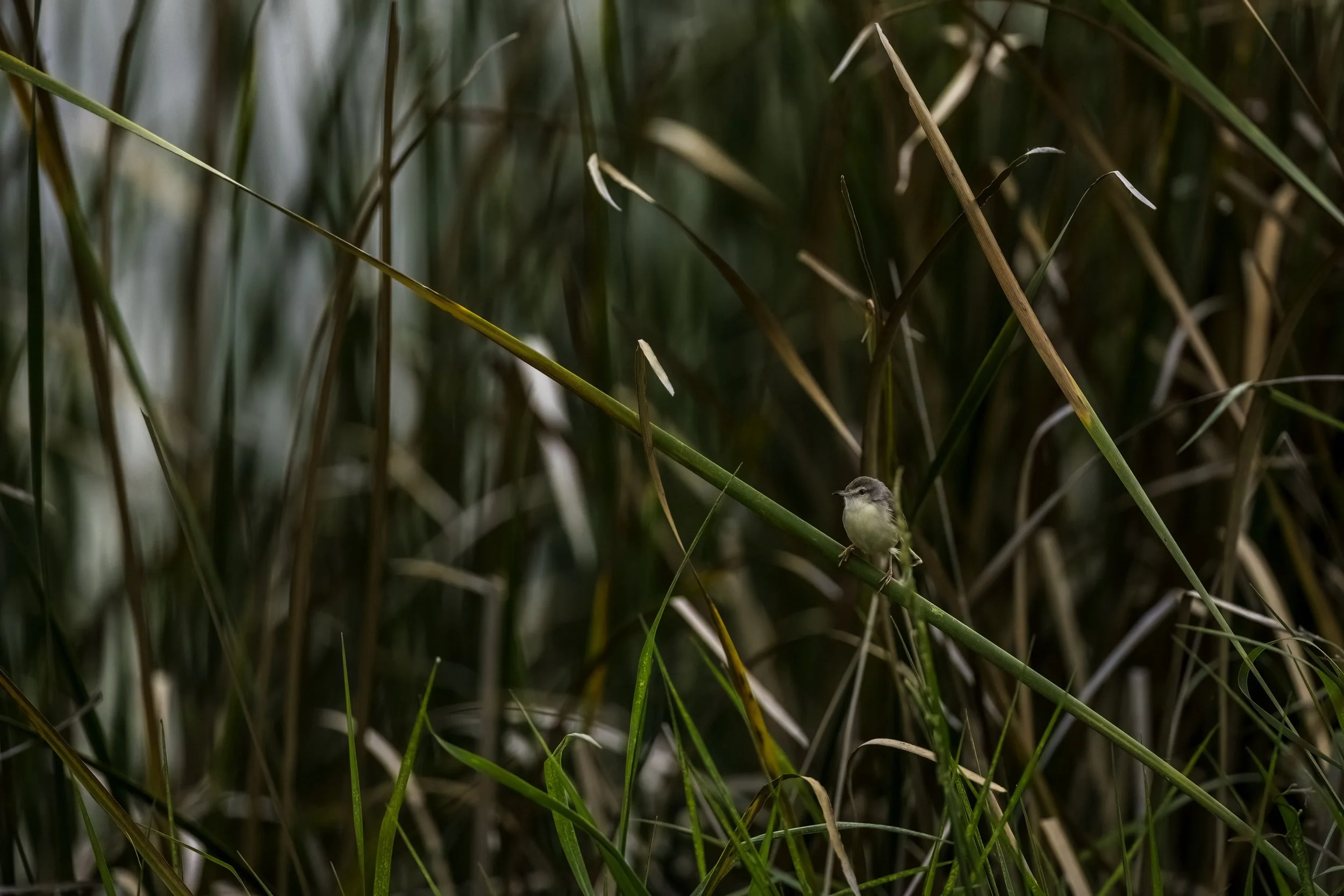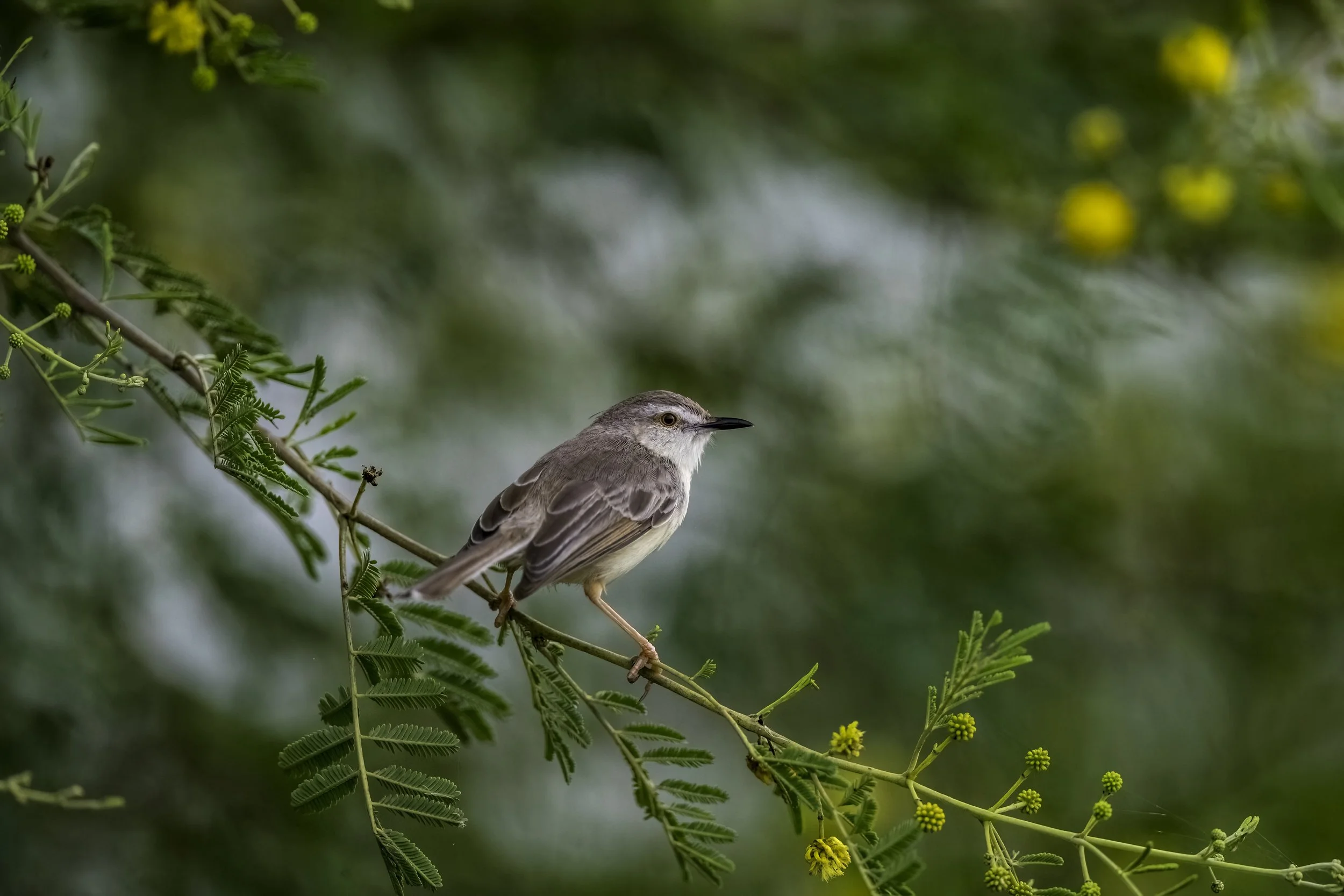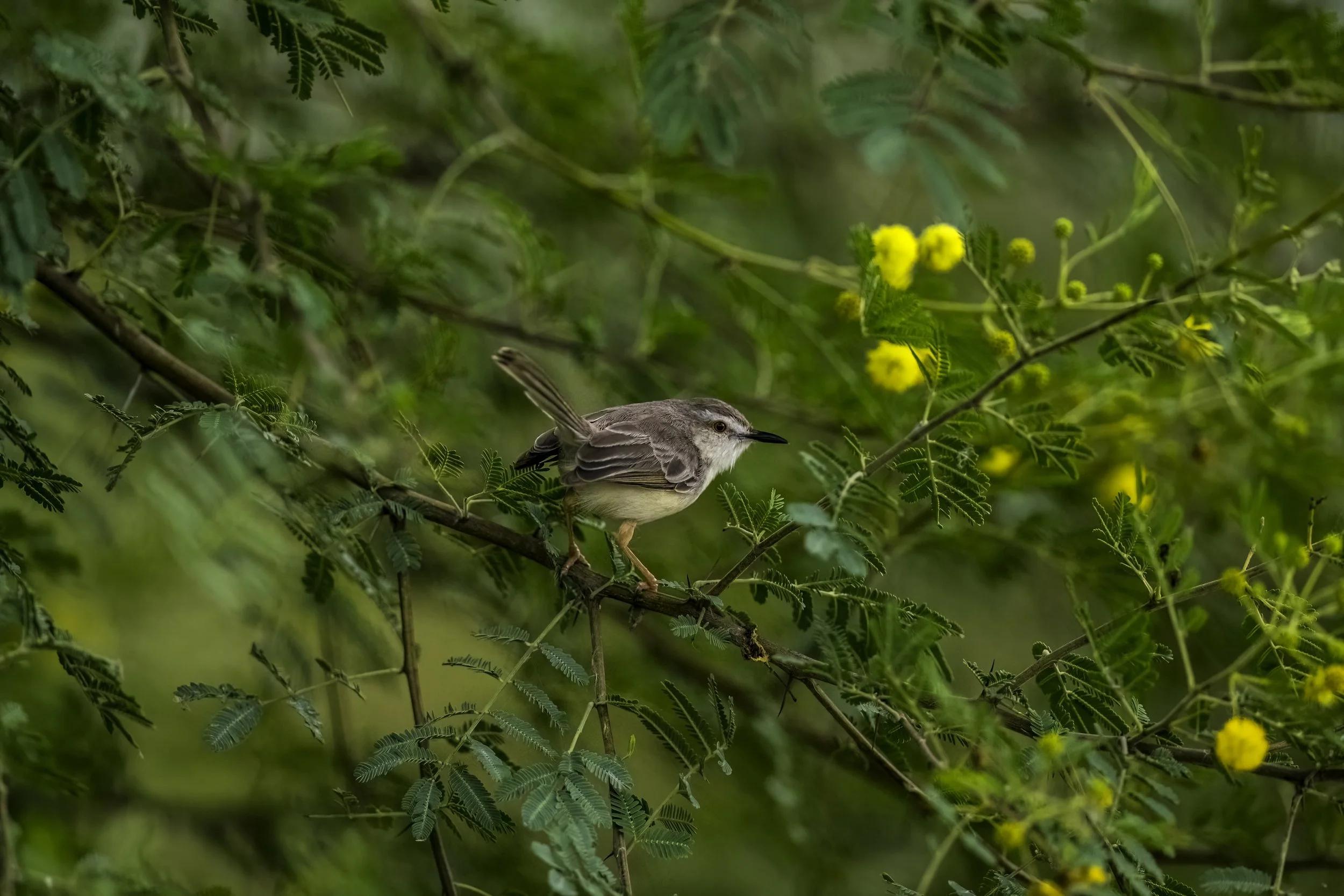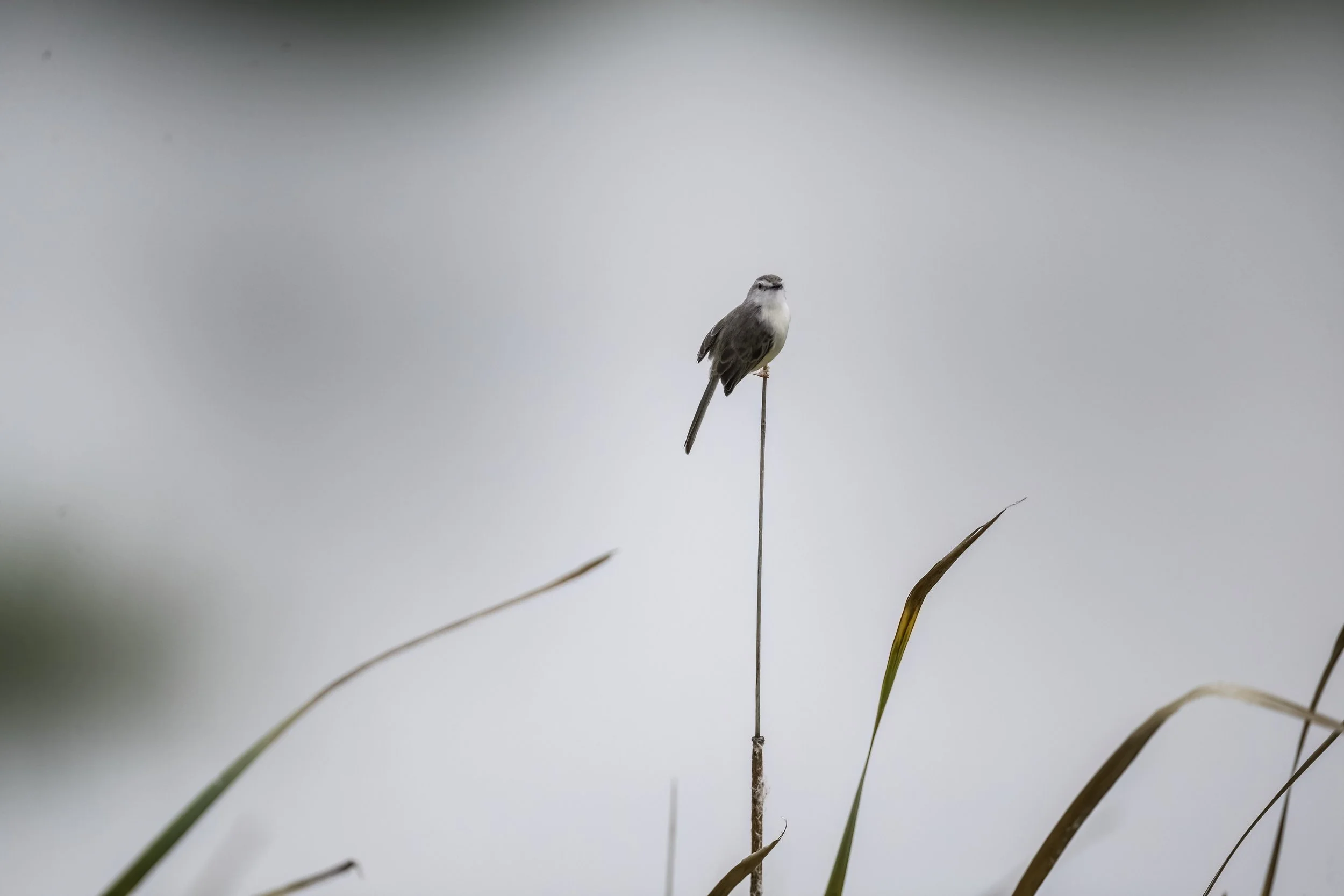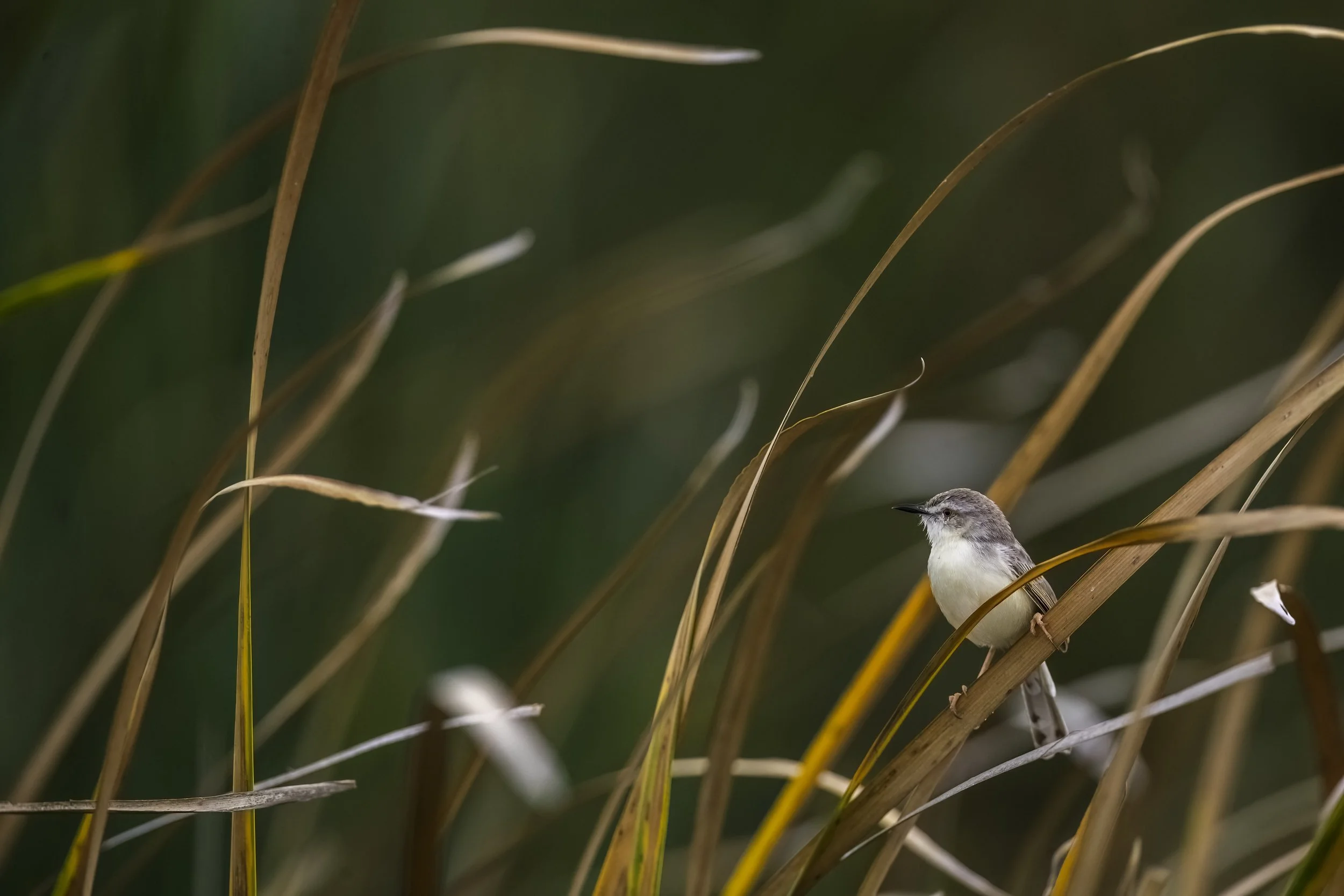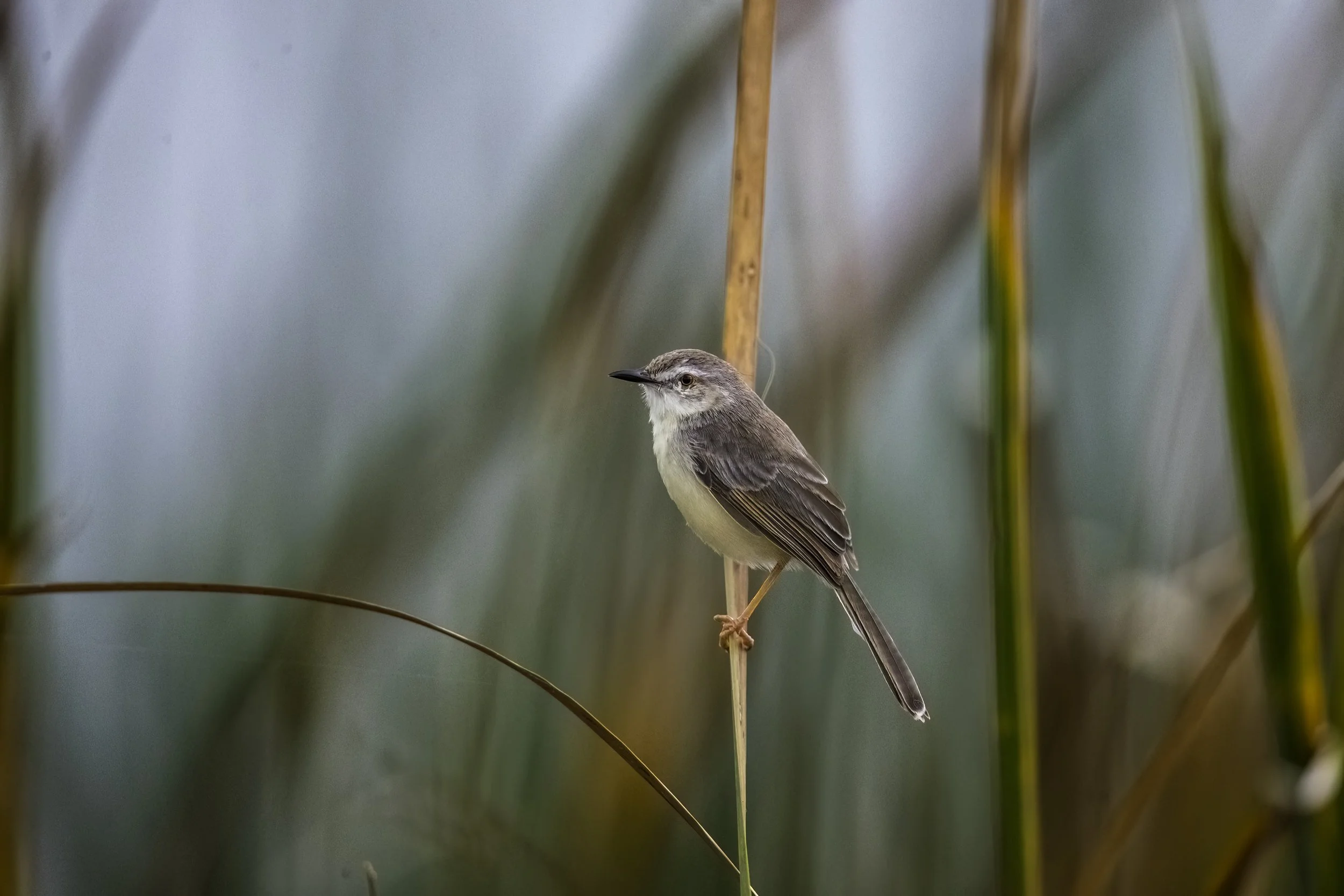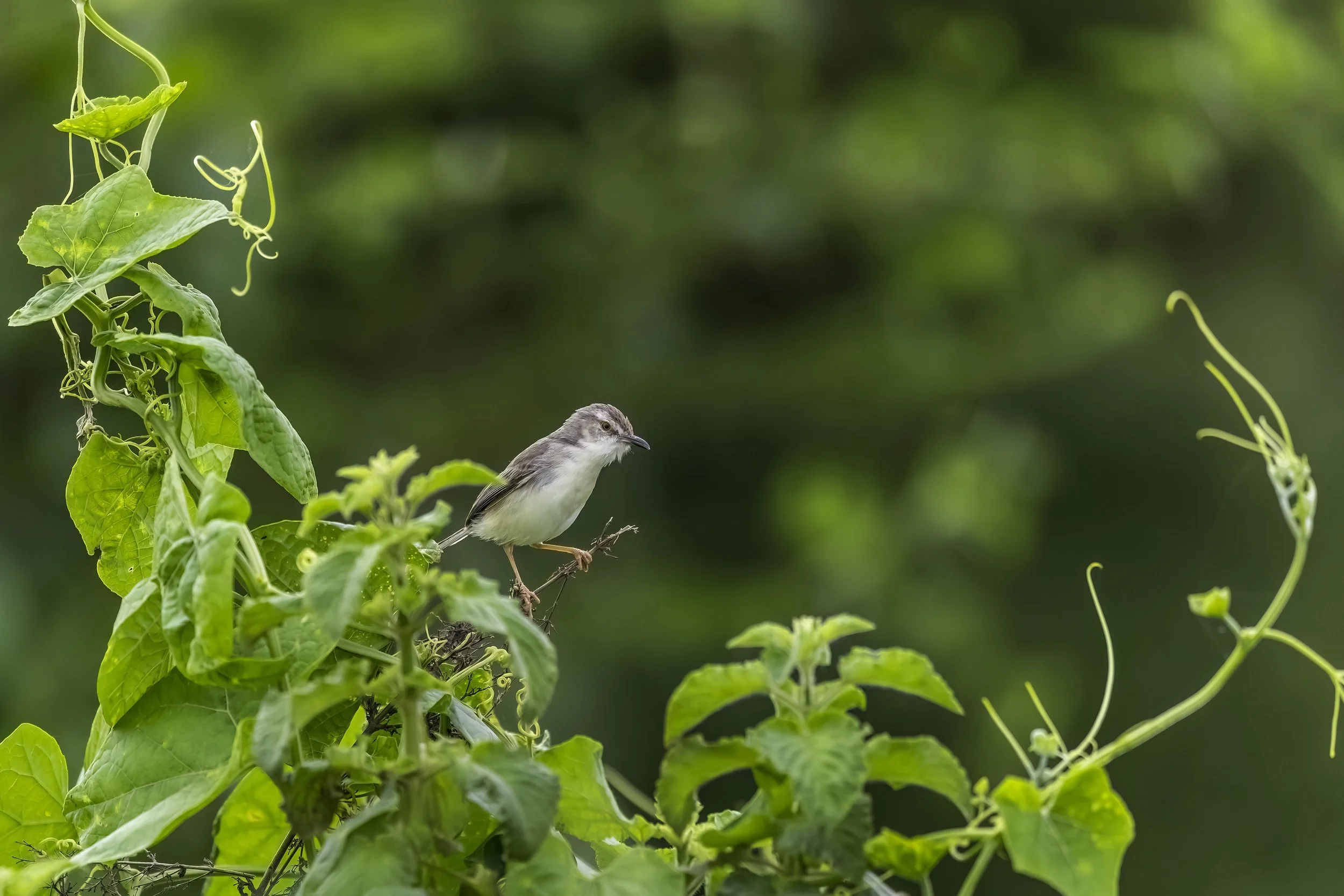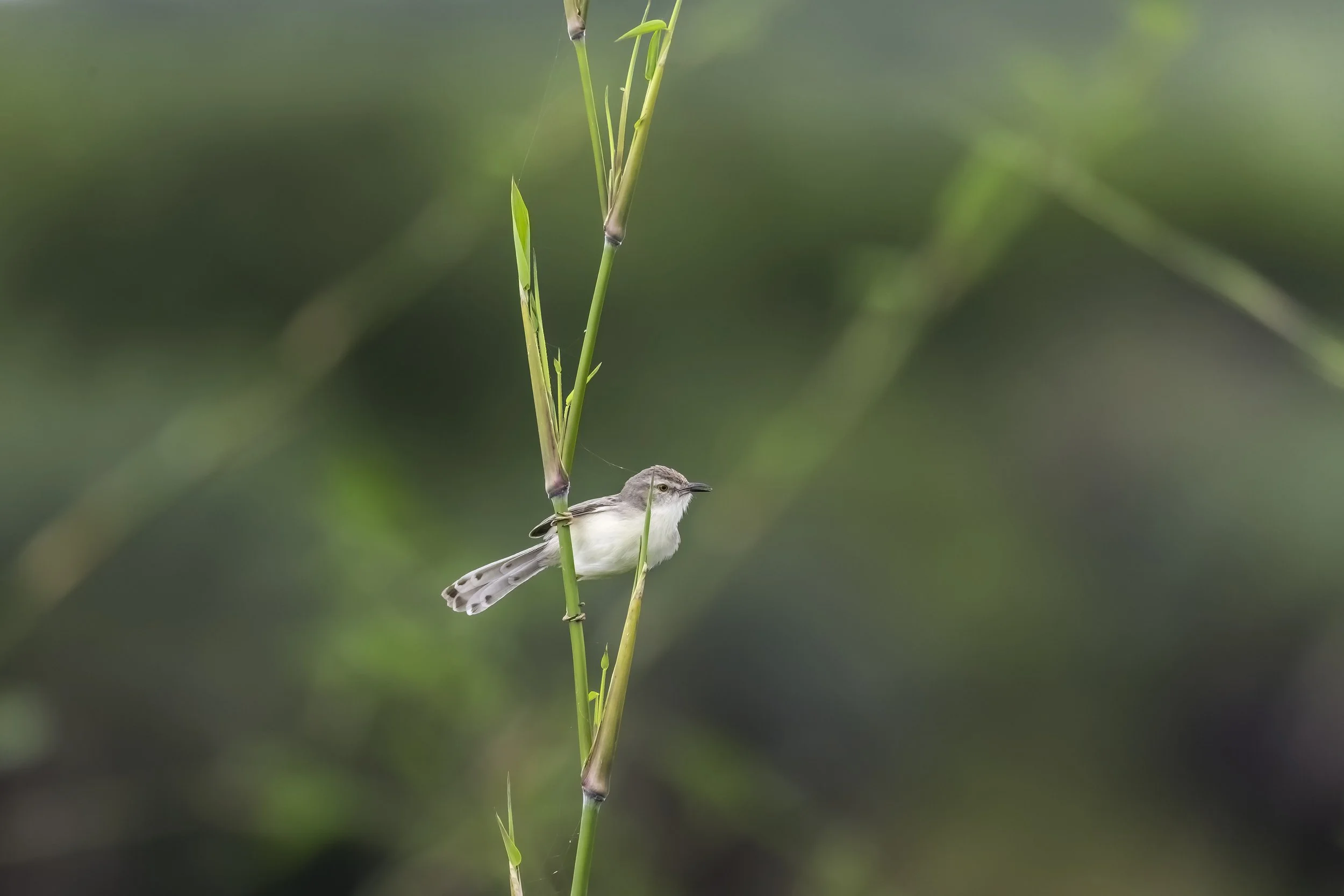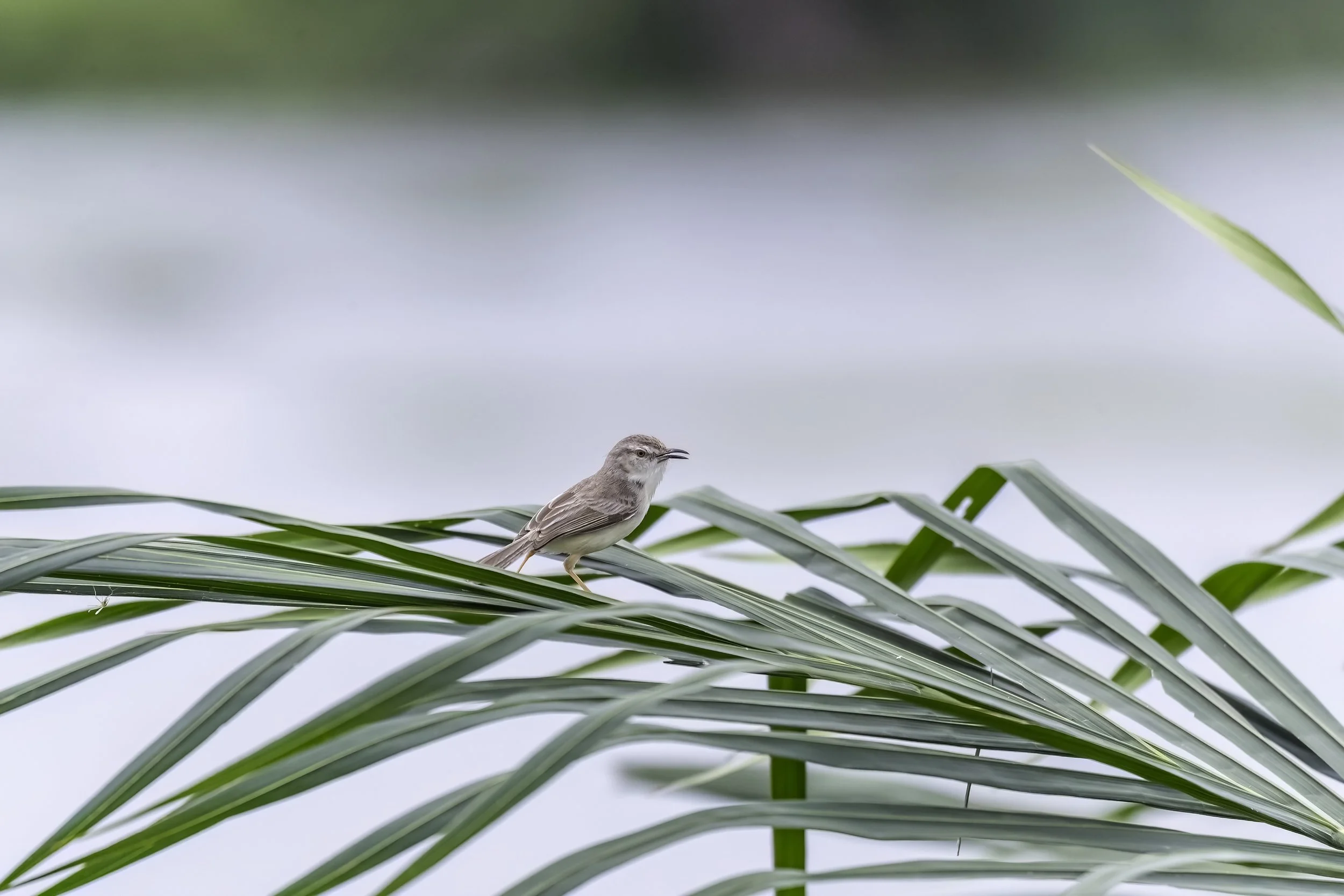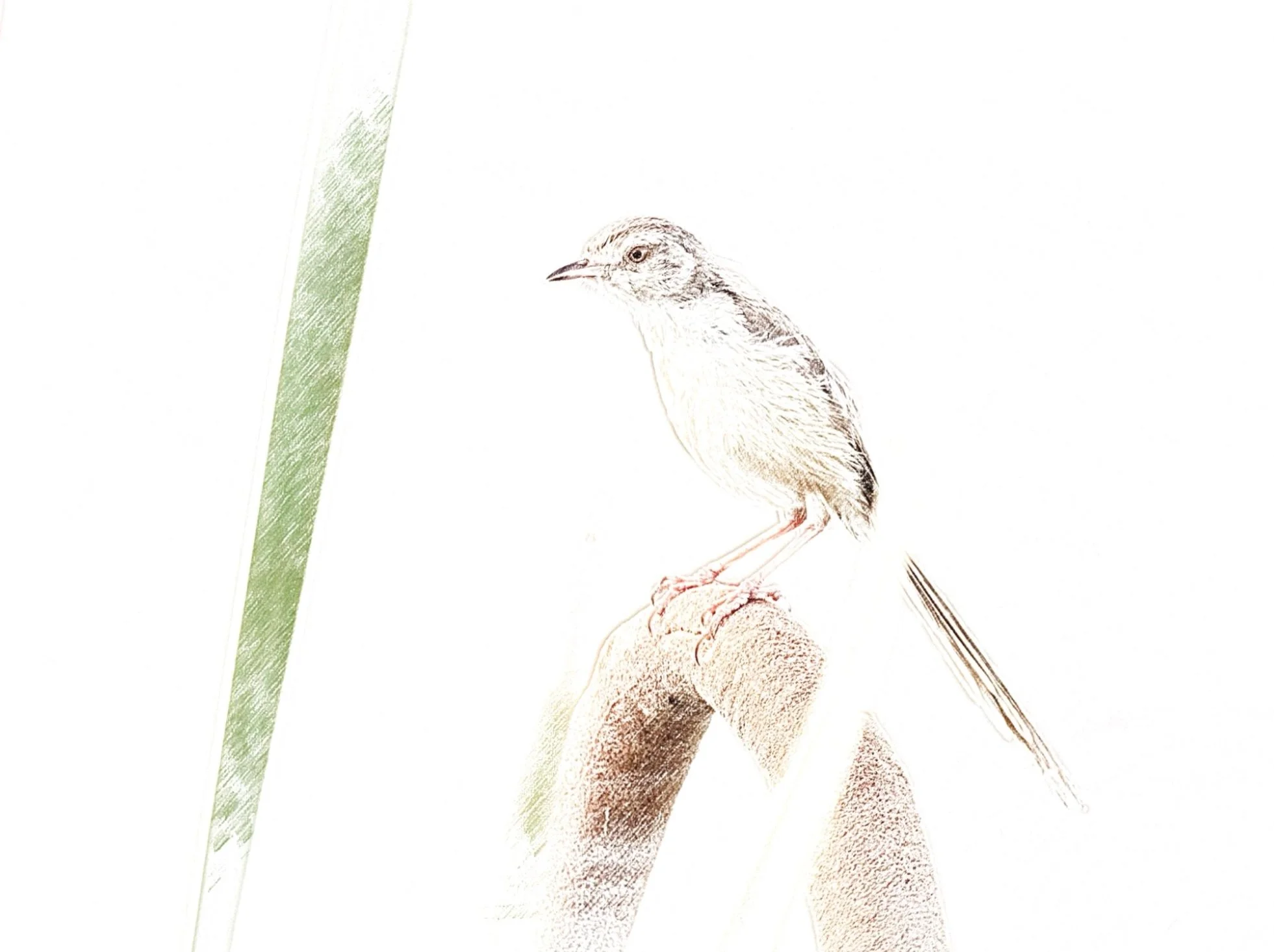Plain Prinia
Prinia inornata
All over India
The Prinia are a genus of small insectivorous birds belonging to the passerine bird family Cisticolidae. They were at one time classed in the Old World Warbler family, Sylviidae. The prinias are sometimes referred to as wren-warblers. They are a little-known group of the tropical and subtropical Old World, the roughly thirty species being divided fairly equally between Africa and Asia. These are birds mainly of open habitats such as long grass or scrub, in which they are not easily seen. They are mainly resident, migration being limited to local cold weather movements. Non-breeding birds may form small flocks.
Prinias have short wings but long tapering tails. They are fairly drab birds, brown or grey above (sometimes with dark streaks) and whitish below. Some species have different breeding and non-breeding plumages. The bill is a typical insectivore's, thin and slightly curved. The genus was erected by the American naturalist Thomas Horsfield in 1821. The type species is the Bar-winged Prinia (Prinia familiaris). The name of the genus is derived from the Javanese prinya, the local name for the Bar-winged Prinia. A molecular phylogenetic study of the Cisticolidae published in 2013 found that the Rufous-vented Grass Babbler did not lie within the clade containing the other prinias. Based on this analysis the Rufous-vented Prinia and the closely related Swamp Grass Babbler were moved to the reinstated genus Laticilla in the family Pellorneidae.
The genus contains 29 species:
Himalayan Prinia (Prinia crinigera) - Distributed in the Himalayas and southern China
Striped Prinia (Prinia striata) - Distributed in China, Taiwan
Brown Prinia (Prinia polychroa) - Distributed in Indochina and Java
Burmese Prinia (Prinia cooki) - Distributed in Burma and southern Yunnan
Annam Prinia (Prinia rocki) - Distributed on the Đà Lạt Plateau
Black-throated Prinia (Prinia atrogularis) - Distributed in the Eastern Himalayas
Rufous-crowned Prinia (Prinia khasiana) - Distributed in Patkai
Hill Prinia (Prinia superciliaris) - Distributed in southern China and Southeast Asia
Grey-crowned Prinia (Prinia cinereocapilla) - Distributed in the Himalayas
Rufous-fronted Prinia (Prinia Buchanan) - Distributed in the northern half of South Asia
Rufescent Prinia (Prinia rufescens) - Distributed in Indochina and northeast India
Grey-breasted Prinia (Prinia hodgsonii) - Distributed in Indochina and South Asia
Graceful Prinia (Prinia gracilis) - Distributed in the Nile valley, coastal East Africa and Western Asia, northern South Asia
Delicate Prinia (Prinia lepida) - Distributed in the Middle East and northern South Asia
Jungle Prinia (Prinia sylvatica) - Distributed in India and Sri Lanka
Bar-winged Prinia (Prinia familiaris) - Distributed in Sumatra and Java
Yellow-bellied Prinia (Prinia flaviventris) - Distributed in the Indus valley, Himalayas and Southeast Asia
Ashy Prinia (Prinia socialis) - Distributed in South Asia
Tawny-flanked Prinia (Prinia subflava) - Distributed in Sub-Saharan Africa
Plain Prinia (Prinia inornata) - Distributed in Indomalaya
Pale Prinia (Prinia somalica) - Distributed in the Horn of Africa
River Prinia (Prinia fluviatilis) - Distributed in the western Sahel and far north-western Kenya
Black-chested Prinia (Prinia flavicans) - Distributed in southern Africa
Karoo Prinia (Prinia maculosa) - Distributed in far-southern Namibia, South Africa and Lesotho
Drakensberg Prinia (Prinia hypoxantha) - Distributed in eastern South Africa and Swaziland
São Tomé Prinia (Prinia molleri) - Distributed in São Tomé Island
Banded Prinia (Prinia bairdii) - Distributed in Central Africa
Red-winged Prinia (Prinia erythroptera) - Distributed in Sub-Saharan Africa (except central, southern and Horn of Africa)
Red-fronted Prinia (Prinia rufifrons) - Distributed in eastern Sahel and Horn of Africa
Species formerly in Prinia but now moved to Laticilla in family Pellorneidae:
Rufous-vented Grass Babbler (Laticilla burnesii)
Swamp Grass Babbler (Laticilla cinerascens)
Today is about one of these birds - the Plain Prinia, also known as the Plain Wren-warbler or White-browed Wren-warbler.
Ameenpur Lake is a man-made lake reportedly built more than 300 years ago by a courtier, Abdul Qadir Amin Khan of Patancheru, during the reign of Ibrahim Qutb Shah (1550–1580 AD). It was constructed to water his gardens which haven’t survived the ravages of time but the lake itself has, albeit, much smaller in size. The lake is urrounded by fantastic primordial rock formations, modern apartments, factories and a village. In its heyday the lake used to occupy more than 300 acres (1.2 km²), but encroachment and development has reduced it today to a mere 93 acres (0.38 km²). The lake has been divided into two sections, Pedda Ameenpur and Chinna Cheruvu.
The lake is teeming with wildlife, including Bar-headed Geese, Cormorants, Ruddy Shelducks, and Gray Herons. Various resident and migratory birds, such as flamingos, egrets, herons, cormorants, kingfishers, and river terns are among the many local and migratory species that flock to the lake making it a major spot for birdwatchers in Hyderabad. The lake had 186 species in 2016 the time of the last count, up from 171 in 2015. In 2017 it was reported that the lake was home to 8 species of mammals, 166 birds, 45 herpetofauna (12 amphibians and 34 reptiles like the Checkered Keelback & the Oriental Garden Lizard), 9 species of fish, and 143 invertebrates (26 aquatic beetles, 41 butterflies, 18 odonates, 25 arachnids, and 33 other invertebrates). Flamingos are the most common birds found here along with the Oriental Darter, Pallid Harrier, Black-tailed Godwit, Painted Stork, River Tern, and Black-headed Ibis which are among the six species categorised as Threatened on the IUCN Red List. Sometimes, if luck favours, the Greater Spotted Eagle - classified as Vulnerable, and the Egyptian Vulture - classified as Endangered, can be seen soaring the skies here.
Today, because of the vast number of migrating birds that thrive there Ameenpur Lake has the distinction of being the first water body in the country to be declared a Biodiversity Heritage Site. The biodiversity tag was awarded for the Pedda Ameenpur Lake, which is at a higher elevation than Chinna Cheruvu. The Ministry of Environment designated Ameenpur as a Biodiversity Heritage Site in November 2016 under the Biological Diversity Act 2002. It is the first body of water in India to be designated as a Biodiversity Heritage Site, as well as the first biodiversity site to be approved in an urban area.
What is a Biodiversity Heritage Site? These biodiversity heritage sites are a region with great biodiversity that are unique, environmentally fragile ecosystems - terrestrial, coastal, inland and marine waters. They exhibit Species richness including both wild and domesticated species, as well as intra-specific categories. There is a high degree of endemism, rare, endemic, and imperilled species, keystone species, evolutionarily important species, wild forebears of domestic/cultivated species or land races or their variants. There is also predominance of biological components indicated by fossil beds that had cultural or aesthetic value in the past. These sites are important for the preservation of cultural diversity; an area with significant cultural, ethical, or aesthetic characteristics. The State Government, in cooperation with local bodies, may designate sites of biological importance as Biodiversity Heritage Sites under Section 37 of the Biological Diversity Act, 2002.
But that said, there are still threats to this beautiful lake. First the size, it is currently spread over 93 acres which is less than a third of its original 300 acre. This reduction was due to development projects which are still ongoing and may eat into the remaining acreage of the lake. There is also a new cinder block brick kiln that has cropped up on one side. Satellite imagery shows effluents from a chemical factory complex being discharged on the western shores. These discharges along with other industrial pollutants released into the lake has caused a reduction in the food chain of birds such as fish and insects which in turn has led to a reduction in the number of birds visiting the lake. And of course the water itself is unfit for drinking. The number of bird species appears to have decreased, there are fewer trees now, and the lake has a bad odour. The biodiversity tag has the potential to conserve lakes that are otherwise fast disappearing owing to urbanization's effects. This categorization has assisted in the prevention of encroachment and waste dumping. If this lake can be saved, it will serve as an example for other lakes throughout the country.
‡‡‡‡‡
For a print of the beautiful birds from the Dois click on the button below to read my process and order a limited edition canvas.
‡‡‡‡‡
Plain Prinia/ Plain Wren-warbler/ White-browed Wren-warbler
The Plain Prinia (Prinia inornata) is a small cisticolid warbler found in Southeast Asia. It is a resident breeder from Pakistan and India to south China and southeast Asia. It was formerly included in the Tawny-flanked Prinia (Prinia subflava), resident in Africa south of the Sahara. The two are now usually considered to be separate species. A common prinia with drab gray-brown plumage that varies in tone across its range. Note the pale, wide eyebrow and the long tail that appears as if it is loosely attached to the body. Breeding birds have a black bill and a shorter tail. Common in various habitats, especially farms and wetlands, but avoids woodlands with a canopy. A somewhat bold species, it often skulks in the undergrowth but sings from exposed perches. Also produces snapping sounds with its wings.
After the Ashy Prinia, this is the species most likely to be observed in Indian cities and agricultural areas. I have seen it in grassland, mixed thorn-scrub and grass, the grassy understory of dry forest, low grass tussocks next to ponds and rivers which is where the first photo is from, patches of scrubby vegetation inside urban areas, elephant grass patches, and even hopping on the ground in recently burnt areas or urban lawns! It usually lives (and sings) close to the ground, only rarely ascending into low trees some meters of the ground. This species poses an identification challenge (especially in the non-breeding season) with the similarly plumaged Jungle and Rufous-fronted Prinias, and to an untrained ear, there are several structural similarities to the song of a Graceful Prinia. When breeding, its distinctive buzzy tzzit-tzzit-tzzit-tzzit song, sounding like pulsing static or an insect, and strongest around 4-6 kHz, helps tell it apart in most of its range.
These 13–14-cm long warblers have short rounded wings, a longish tail, strong legs and a short black bill. In breeding plumage, adults are grey-brown above, with a short white supercilium and rufous fringes on the closed wings. The underparts are whitish-buff. The sexes are identical. In winter, the upperparts are a warmer brown, and the underparts more buff. The tail is longer than in summer. There are a number of races differing in plumage shade. The endemic race in Sri Lanka retains summer plumage, including the shorter tail, all year round. This skulking passerine bird is typically found in wet lowland grassland, open woodland, scrub and sometimes gardens. The plain prinia builds its nest in a shrub or tall grass and lays three to six eggs. (The tawny-flanked prinia nests in herbage and lays two to four eggs).
Like most warblers, the Plain Prinia is insectivorous and their song is a repetitive tlee-tlee-tlee. Outside of the breeding season, this song is infrequent, and call notes are the best way of identifying this species. In alarm or during pair confrontations, Plain Prinias utter an irregular series of hard tHILp notes between 3.5-5 kHz, something like tHILp–tHILptHILp—tHILp—tHILptHILptHILp. This irregularity (and the higher pitch) is key to telling them apart from a Jungle Prinia. The most diagnostic call, however, and one that is consistent across the Indian range of this species, is a sharp buzz between 4-6 kHz (the bzzt call), which helps differentiate this species from all others. It is lower in pitch and broader across the frequency band than the ‘snore’ call of the Graceful Prinia, and is often uttered in flight when the bird flushes. Training your ear to listen for it will help detect and identify this bird across all seasons.
The Plain Prinia is a small, olive-brown or reddish-brown prinia, unmarked, with whitish superciliary and underparts, and a very long, graduated tail (shorter and less graduated during breeding). The nominate race in their non-breeding plumage has yellowish-white lores and a narrow eyerim, the short superciliary rather pale whitish (to just behind the eye). The crown, ear-coverts and the entire upperparts including upperwings are a warm brown, the wing feathers are edged rufous, the tail is dark brown and the outer feathers have a distinct dark subterminal mark and buff tip. The bird is strongly washed with warm buff below, becoming whiter on the chin and central belly, the iris is orange-yellow to reddish-orange and the upper mandible is horn-brown while the lower mandible is pinkish. The legs are a brownish-yellow. In breeding plumage it is pale brown-grey above, with upperwing coverts and tertials edged pale grey to pale rufous, the tail feathers becoming progressively paler towards the outermost, which is almost whitish. It is very pale below, almost whitish, with a faint yellowish wash on the flanks and thighs and sometimes (in very fresh plumage) on the breast. The bill is black as well as the inside of the mouth. It can be distinguished from the very similar P. sylvatica mainly by its smaller size, less bulky appearance, narrower-based tail, weaker legs, smaller bill, more prominent supercilia, and no dark mottling on the lower malar region (close inspection required). The sexes are similar while the juvenile resembles the breeding adult in tail length, but has more rufous-brown upperparts and softer plumage.
Complex racial variation, usually involving differences in colour saturation between non-breeding (winter) and breeding (summer) plumages, Northern populations tend to have longer tails in non-breeding plumage and more marked colour differences between the two seasonal plumages: non-breeding terricolor has rufous-brown upperparts, brighter on the rump and uppertail-coverts, a very long tail with indistinct subterminal and terminal markings, while in breeding plumage the tail is much shorter; fusca is similar to the previous one but darker, with rufous upperparts and deeper buff underparts in the non-breeding plumage, slightly darker and browner in the breeding plumage; blanfordi is similar to the previous one but a little darker than rufous color above, and has a pale yellowish beige wash on the lower parts; extensicauda in breeding plumage is very dark brown above, only weakly washed beige underneath, the tail marks are indistinct; in non-reproductive plumage it has the brown-grayish upper parts washed with rufous and a weak beige wash underneath. Flavirostris is a little more gray in the breeding plumage and more olive-like above in the non-reproduction compared to the previous one; herberti in reproduction is intense warm brown olive on top, with buff washing on the flanks and often on the chest, strong white superciliary buff, in non-reproduction is very dark brown olive ove above with diagnostic black streaks on the forehead, tail with bold black subterminal marks and white tips. Franklinii is darker and browner than the nominal in all plumages, the tail especially dark, with bold blackish subterminal marks and sometimes white tips on the outermost feathers while insularis has both similar plumages, resembling the breeding plumage of the previous one, it has a shorter tail than other breeds and blythi is quite light grayish brown above and very warm beige, leaning to the rufous, in the lower parts.
It is believed that their closest relatives are the Tawny-flanked Prinia (Prinia subflava), the Pale Prinia (Prinia somalica) and the River Prinia (Prinia fluviatilis). Sometimes it is treated as conspecific with the Tawny-flanked Prinia (Prinia subflava), but it differs vocally and, to some extent, in the colouration of the plumage. This creates a complicated situation if the geographical variation is also included and more study is required. The Sri Lankan insularis breed shows differences in singing with respect to the continental races, and the Java blythi breed is also reported to differ vocally and both need additional studies. Ten subspecies are recognized:
Prinia inornata terricolor - Distributed in Eastern extreme of Afghanistan (Jalalabad) and O of Pakistan (Khyber Pakhtunkhwa and margins of Baluchistan) East over the WE of India (E to Vadodara) to the South of Nepal.
Prinia inornata inornata - Distributed in C and the EE of India (S of the Ganges plain).
Prinia inornata franklinii - Distributed in Southwest India (southern Karnataka, Kerala, western Tamil Nadu).
Prinia inornata insularis - Distributed in Sri Lanka
Prinia inornata fusca - Distributed in the lowlands from Nepal to E to Bhutan, Bangladesh, NE of India (E to Arunachal Pradesh, Assam, Nagaland and Manipur) and S of Myanmar.
Prinia inornata extensicauda - Distributed in S and E of China (N and E of Yunnan, O of Sichuan E to Jiangxi and Zhejiang, also Hainan) S to N of Laos and N of Vietnam (Tonkin).
Prinia inornata blanfordi - Distributed in NC and E of Myanmar, NW of Thailand and S of China (W of Yunnan).
Prinia inornata herbed - Distributed in S Myanmar (Tenasserim), C and E Thailand, Cambodia, C and S Laos and C and S Vietnam.
Prinia inornata flavirostris - Distributed in Taiwan.
Prinia inornata blythi - Distributed in Java
The Plain Prinia frequents scrub pastures in various situations, from marshes to cane fields, bamboo thickets, especially wheat crops (Triticum) and gardens covered with weeds. In general the bird prefers more humid habitats than those frequented by the Jungle Prinia (Prinia sylvatica), but drier than those occupied by the Ashy Prinia (Prinia socialis), although they overlap a lot. They avoid very wooded areas, but tolerate the secondary growth of scrubland, tamarind thickets and the edges of mangroves. In the western Ghats and the Nilgiris (southern India) they are also seen on fern-covered slopes and herbaceous plateaus with thickets of Berberis, Rubus and Hypericum and some locally even in sandy or stony semi-deserts. They are found at an elevation of up to 800 m from the sea level in general, but reported up to 1200 m at the foot of the Himalayan range, 1500 m in Java, 1800 m in the soth of India and 2100 m in Sri Lanka.
The Plain Prinia is a largely resident with some altitudinal movement, with post-nuptial decline from the highest areas to the lowlands. In Pakistan, pre-breeding dispersion carries the dispersants from the Indus plains to the foothills of Baluchistan and the northwestern border. They take a variety of small invertebrates mainly insects and their larvae and among the registered objects are small flies (dipterans), grasshoppers (orthopterans), ants (hymenopterans), small beetles (coleopterans) and caterpillars (lepidopterans). Observations of birds with pollen spots on their foreheads suggest that they feed on nectar, but pollen possibly acquire it by looking for insects in flowers. They are usually alone or in pairs and is not shy, but generally discreet, staying low in the vegetation. It feeds near the ground, climbing on stems or inside the bushes collecting insects from the leaves and the floor. The Plain Prinia flies weakly, staying crouched, for a few meters before diving back into the cover.
The Plain Prinia is not globally threatened (classified as Least Concern) and common in much of its extensive distribution area. One of the most widely distributed members of the genus and It is clear that the Plain Prinia has adapted well to living with humans, which will undoubtedly guarantee its survival in the foreseeable future.
‡‡‡‡‡
Related Posts


